GROOVE CRUISE: 35TH EDITION
SOUL CLAP’S ELYTE: REDEMPTION SONGS

SOLVING DJ-BUSINESS CHALLENGES

THAILAND’S WONDERFRUIT
DADA LIFE
MATT GUY
PIONEER DJ DDJ-FLX4
KRK GOAUX 4
CUSTOMER-SERVICE TIPS FOR MOBILES





GROOVE CRUISE: 35TH EDITION
SOUL CLAP’S ELYTE: REDEMPTION SONGS

SOLVING DJ-BUSINESS CHALLENGES

THAILAND’S WONDERFRUIT
DADA LIFE
MATT GUY
PIONEER DJ DDJ-FLX4
KRK GOAUX 4
CUSTOMER-SERVICE TIPS FOR MOBILES




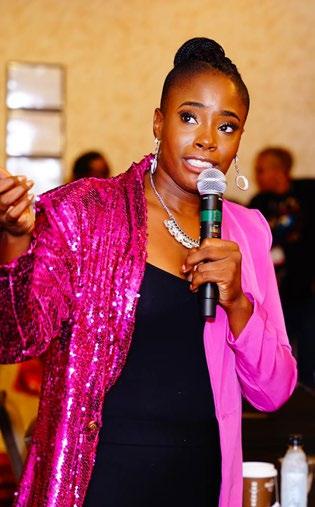
Atlantic City, N.J. – Mark your calendars, DJs, because DJX ’23 is right around the corner.
Set for August 7-10 at the Hard Rock Hotel & Casino in Atlantic City, N.J., DJX will bring the entire DJ industry together with its winning combo of new technologies, education, and sponsored After Dark events.


Produced by DJ LIFE magazine and Hazan Media Group, DJX will present a showfloor full of the latest DJ-related products (audio, lighting, accessories and more), a slate of 30 seminars, panels and keynotes tackling the latest topics, and nightly parties featuring top DJ talent. Operating since 1990, DJX is the longest-running and most-impactful trade show/ event in the North American DJ industry. Whether you’re a mobile jock, club DJ, bedroom spinner or music maker, DJX ’23 will have something for you.
Just Announced Sessions: As is often the case, mobile vet Mike Walter will present a new, special session at DJX – “Lessons from My 35 Years as a Mobile DJ.” His story is worth repeating. After beginning his career at a very successful multi-op, Walter went on to own his own outfit, Elite Entertainment. Along the way, he’s experienced a lot and learned even more. In this seminar, he’ll share tips about sales and marketing, training and managing talent, and staying relevant to have a decades-long career in the business.
This year, Philly-based DJ Greg Curran of the DJ Entertainment School will helm a pair of seminars – one for newbies, the other for vets. On “Lifelong Lessons for Beginner DJs,” Curran will tackle everything from microphone skills to networking and building your DJ brand. Then, on “The Pricing Panel,” Curran and a panel of veteran mobile jocks will discuss how to set prices for your market.
Joshua Lask of the Hudson Valley Event Group in Monroe, N.Y., will deliver a session for single-operating DJs who are looking to go multi-op. In “Giving Up Control: Building Leaders to Scale Your DJ-Company Brand,” Lask will teach attendees the art of letting go and delegating by understanding when and how to place people in positions of power. He will help attendees understand and embrace the emotional
roller coaster of relinquishing responsibility. He’ll teach them how to balance time vs. money, and he’ll teach how to execute as a team to boost profits and performance.
Philadelphia-based Vernique Fields (aka Neeek Nyce) of Into Fields Live Entertainment will helm a seminar that discusses the concept of inclusivity in the DJ industry – “Don’t Judge a Book By Its Cover. ” This youth-driven panel discussion –featuring International Kidz DJ Café – will describe the challenges that are faced by DJs of all ages and demographics on how they overcome their obstacles in their professional careers.
For the latest on DJX ’23, please visit www.djxshow.com.
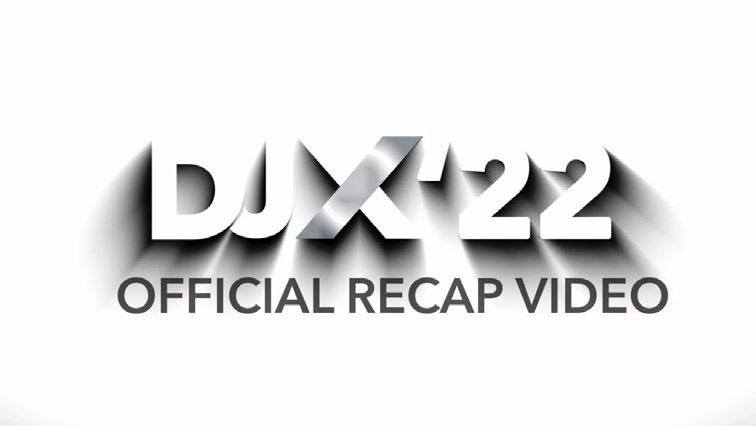
Miami, Fla. – Though Winter Music Conference remains on pause, much of the dance-music world will descend on South Florida this March 21-26. Highlighted by Ultra Music Festival (above) at week’s end, MMW will see the world’s top electronic jocks spin a variety of clubs, festivals, and private events.
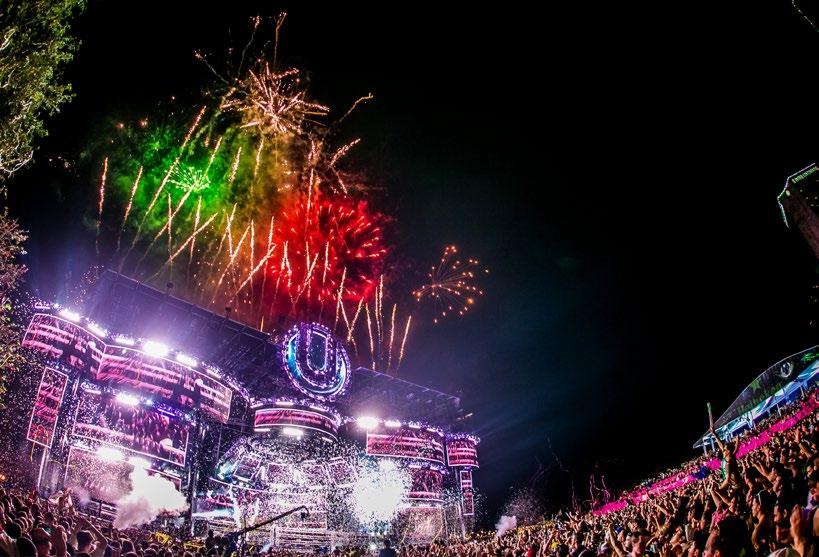


Connected by a SocialJustice Nonprofit Org, Soul Clap’s Eli Goldstein Brings a Poetic Voice from Prison

 By Jim Tremayne
By Jim Tremayne
10 Sound Bites Dada
Guy

12
The Groove Cruise Delivers Top DJs for 35th Edition
 By GC Photographers
By GC Photographers
28

If you’ve hit the electronic-music festival circuit the past few years – both pre- and postCovid times – you’ve certainly noticed that bass music and all its permutations (dubstep, bass house, trap, etc.) have maintained a stranglehold on the mainstages. And given the massive sound systems these DJs play through, it can make for a teeth-gnashing, brainrattling experience – just the way the kids like it. But, as it stands now, there are really few genre talents that can match Subtronics for wub, womp, and wattage.
I first caught the 30-year-old Philly-based DJ/producer (aka Jesse Kardon) this past summer at Electric Zoo festival on New York City’s Randalls Island and, once his mainstage set began, it was impossible not to think, “OK, this sound is totally on another level.” Blasting tunes from his 2022 full-length Fractals – on his own Cyclops Recordings – Subtronics rocked the joint for an hour with intricately compelling soundscapes to match the seismic bottom. Really, nobody else sounds like this guy. So, as Subtronics began his 2023 AntiFractals Tour, our Brian Bonavoglia connected with the genre giant.
In our Sound Bites column, we visit with Dada Life, Sweden’s wacky electronic duo and discuss its latest single, “Take Me Into Space,” a collab with Chinese DJ/producer DEXTER KING. Additionally, I get some studio talk with U.K. talent Matt Guy, who has struck gold with his affinity for retro tunes in the form of hits like “Set My Mind Free.”
Also, in a unique pair of Q&As, we connect with Eli “Elyte” Goldstein of Soul Clap and Nebraska inmate Russell Wardlow (aka WayOfLife), who collaborated on a full-length album – no mean feat, given Wardlow’s circumstances. After meeting through Give A Beat , – a social-justice-driven non-profit organization – the two created a nine-cut, hip-hop album full of life and trauma, regret and redemption.
On the lighter side of life, we reveal what went on aboard the 35th edition of the Groove Cruise, which ventured from Miami to Haiti and back, and presented DJs of all genres, including Claptone, Markus Schulz, Nora En Pure, and Jauz. And for Festival Spotlight, Viet Nam-based scribe Saxe Colson reports from Thailand on Wonderfruit, one of the world’s more unique festival experiences.
In our tech-review columns, Denver-based Wesley King takes on KRK’s very mobile GoAux4 monitors in Studio Session. For Playback, Minneapolis-based DJ Deets puts Pioneer DJ’s DDJ-FLX4 controller through its paces. In this issue, we also offer an expanded Gear section.
In the mobile-DJ world, we ask several top practitioners how they handle their biggest business challenges – from procuring to pricing. In Mobile DJ Profile, we talk with New England DJ vet Ken Cosco, who dishes sage advice and explains how he’s navigated his way to success. In DJ Business, Rochester, N.Y.-based Joshua Volpe discusses why customer service is more important than it’s ever been and offers new ways to communicate with clients.
And don’t forget: DJX’23 is all set for Aug. 7-10 at the Hard Rock Hotel & Casino in Atlantic City, N.J. In addition to an exhibit hall full of the latest DJrelated gear, 30 seminar/keynote sessions, and sponsored After Dark events, the show will offer some new wrinkles – including “The DJ’s Vault Live” (please see Pg. 8) We hope to see you there.
Cheers, Jim Tremayne Editor, DJ LIFEeditor-in-chief
Jim Tremayne jtremayne@hazanmediagroup.com
editor-at-large
Brian O’Connor boconnor@@hazanmediagroup.com
web editor and social media manager
Mark Mancino mmancino@@hazanmediagroup.com
contributors
Wesley King, Chris Caruso, Amanda Chavez, Shawn Christopher, Paul Dailey, Reed Dailey, Chris Davis, DJ Deets, Tony Fernandez, Tommy D Funk, Lexi Ferguson. Ryan Hayes, Greg Hollmann, Erik Miller, Lily Moayeri, Jordan St Jacques, Jeff Stiles, Ashley Teffer, Danny Turner, Phil Turnipseed, Joshua Volpe, Travis Wackerly, Curtis Zack
chart coordinator
Dan Miller dmiller@hazanmediagroup.com
national sales manager
Josh Kerman jkerman@hazanmediagroup.com

creative director
Janice Pupelis jpupelis@hazanmediagroup.com
director of technologies and project management
Steve Thorakos sthorakos@hazanmediagroup.com
Chairperson & COO/Co-Publisher
Robin Hazan rhazan@hazanmediagroup.com
President & CEO/Co-Publisher
Shawn Hazan shazan@hazanmediagroup.com

visit
516.767.2505
Editorial and Sales Office: DJ Life, Oyster Bay, NY 11771. (516) 767-2505 • (Sales/all other business): (516) 767-2505 • djlife@hazanmediagroup.com.
Editorial contributions should be addressed to The Editor, DJ Life Mag, Oyster Bay, NY 11771 or sent to JTremayne@hazanmediagroup.com.

DJ Life Mag is published bi-monthly starting with the second month annually.
Design and Contents: copyright © 2023 by DJ Life Mag and must not be reproduced in any manner except by permission of the publisher.
Web: DJLifeMag.com DJXShow.com and HazanMediaGroup.com
Subscriptions: Complimentary Digital Edition. Email: djlifemag@hazanmediagroup.com Phone: 516-767-2505 ext. 502 Web: djlifemag.com/subscribe
nXt INITIATIVES INCLUDE:
> Onsite Experiences & Activations






> nXt@DJX DJ Summer Camp
> Talent discovery
> Education / Networking
> Product Drops
> Discounts to Atlantic City attractions
nXt @DJX was designed to ensure opportunity for emerging DJ talent to be heard, discovered, educated and inspired at DJX, the industry’s largest and most impactful gathering of professional DJs. Additionally, it offers industry professionals an ongoing opportunity to See Hear & Connect with the influential future of the DJ community.
#CALLINGALLDJS

DJXSHOW.com



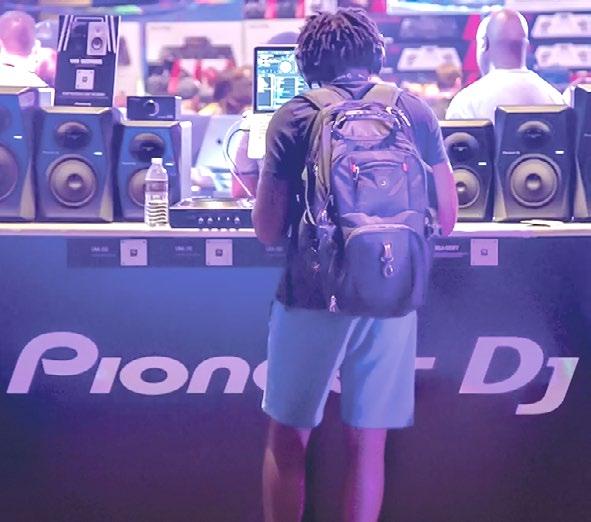

Atlantic City, N.J. – DJX ’23 is set for Aug. 7-10 at the Hard Rock Hotel & Casino in Atlantic City, N.J. With its winning combo of new technologies, education and entertainment, the show remains the longest-running and most-impactful event in the DJ industry.

But DJX ’23 also has some new things in store. For one, it will showcase a new collaboration between the show’s producers and an industry mainstay. To wit, Hazan Media Group (HMG) –publishers and producers of both DJ Life Digital and DJX Show – and The DJ’s Vault – an educational, subscription-only website –have agreed upon an ongoing alliance “aimed at strengthening the DJ community.”
The collaboration will leverage the impact, relationships, and reach that both companies share. Under the umbrella of education and the power of networking, the platforms’ initiatives will be centered on the passion that’s unique to the DJ community.
To begin, DJX’23 will house the premiere of “The DJ’s Vault Live,” an in-person extension of the highly regarded membership service featuring the platform’s creator Joe Bunn. Offering valuable direction on owning and running a successful DJ company and available to DJX attendees with “All-Access” passes, Bunn will present two 60-minute tutorials at the show.
Accordingly, portions of The DJ’s Vault and its archives will be available via DJ LIFE Digital. Additionally, The DJ’s Vault will host DJ LIFE Magazine Editor Jim Tremayne and HMG CEO/Partner Shawn Hazan to begin conversations with the industry. The collaboration will also focus on making their services more accessible to the industry via cross-marketing opportunities and messaging.
All participants say they look forward to the collaboration and believe the DJ industry will benefit.
“We’re excited to work with a successful industry personality like Joe Bunn,” says Jim Tremayne, DJ LIFE Magazine Editor and DJX co-organizer. “Throughout his career, Joe has consistently pushed for the betterment of the industry, and in the past, we have presented him on DJX panels. He always draws the audience’s attention and offers useful solutions. Working with him on ‘The DJ’s Vault Live’ series will be an exciting development at DJX.”
Says Joe Bunn of The DJ’s Vault: “Getting to know the new team at DJX gives me confidence in our combined ability to make a difference in the industry. Their vision for the community is refreshing and they share the same passion that we have for the industry. Their message is resonating, and we are excited to add to that experience with the launch of ‘The DJ’s Vault Live.’ It was obvious from our first conversations that these guys have the experience and proven results to execute and bring this industry closer together.”
Adds HMG’s Shawn Hazan: “Developing ongoing opportunities for DJs through our brands is a vital part of our purpose and commitment to the DJ community. Working with Joe Bunn and The DJ’s Vault shows leadership and brings into vision opportunities to do more for the industry. This is an exciting start to ’23.”
HMG is an integrated media company that positively impacts the lifestyle markets. HMG provides strategic solutions for our audiences by creating award-winning content, education, brand experiences and advisory services.
The DJ’s Vault is an online educational environment, which serves the mobile-event DJ community and covers topics that help DJs run a more profitable business.
For the very latest on DJX ’23, please visit www.djxshow.com.
Small,






















































































































































































































































































































































































































































































It’s certainly safe to say a lot has changed in the world of electronic-dance music since 2006, but one thing remains the same. After 17 years of performing wild shows and making a string of popular party records, the Swedish DJ duo Dada Life still knows how to make a crowd go bananas.

Consisting of Olle Cornéer and Stefan Engblom, the group has built a global audience on the strength of its hard-hitting anthems, like 2011’s “Kick Out The Epic Motherf**ker,” 2014’s “Born To Rage,” and 2020’s “This Time (Never Be Alone Again) ” And the shows? That’s another level of craziness, complete with the duo’s ongoing obsession with bananas (consuming and wearing), champagne (consuming and spraying) and general frivolity. In fact, Cornéer and Engblom found themselves etched in some quirky history, as they helped break two Guinness World Records for the biggest pillow fights in the world – with 5,000 pillows.
As we enter 2023, Dada Life recently teamed up with one of China’s finest talents, DEXTER KING, for their booming collaboration, “Take Me Into Space.” So, we felt the time was right to catch up with the dynamic Dada duo.
DJ LIFE: How would you say that Dada Life’s sound has evolved since the group first popped onto the scene in 2006?
Stefan Engblom: We don’t think so much about the music we do. We never follow trends. We just make the music we love. So, our sound has probably changed a bit during the years, but not too much. Right now, we’re leaning towards harder sounds, more inspired by the kind of techno we grew up with.
DJ LIFE: What do you think has been the key to Dada Life’s success and longevity?

Olle Cornéer: I think the reason we keep doing this is because we love it. If you create music because you love it, you can ride the waves of success and failure easily.
DJ LIFE: In your view, how has the electronic-dance-music landscape changed since the group’s beginnings?
Engblom: You make us feel so old! [laughs] But, we actually do remember when vinyl was the main format and DJs carried huge bags for each gig. When we released our first single – “Big Time” in 2006 – it was on vinyl. It has changed a lot. It’s gone from being something “underground” to becoming “mainstream” and exploding in a thousand micro-genres. But the essence of dance music is the same: Getting together in a sweaty place to lose yourself and just smile.
DJ LIFE: What advice do you have for up-and-coming DJ/producers who want to ascend to a lofty spot in the electronic-music world?
Cornéer: Learn by copying other peoples’ sounds until you’re good enough. And then stop copying altogether and create your own thing. If you do it because you love it – and not because you want to be successful – you will make it. Hopefully.
DJ LIFE: When it comes to music production, what gear and programs are you using in the studio these days?
Engblom: We use Ableton Live and have for over 10 years now. When it comes to plug-ins, that changes all the time. We use our own plug-ins – Sausage Fattener and Endless Smile – all the time, of course. Apart from those, we love the stuff from Oeksound, Valhalla and Xfer Records right now. We also have a bunch of synthesizers we use from time to time – but most of our sounds come from plug-ins.

DJ LIFE: When you two have a rough week or hit a wall creatively in the studio, how do you get back on track?
Cornéer: If we hit a wall with a certain song, we just drop it for a week or two, and work on another one. Then, when we get back to the first one, it usually sounds fresh, and you know instantly what was wrong and how to keep going.
DJ LIFE: Tell us a little about your new single, “Take Me Into Space,” with DEXTER KING and how it came together.
Cornéer: The aim with this song was to make something that could shatter the Earth and lift you to the sky like a rocket, because when that happens, you can’t stop smiling.
Engblom: We both wanted to make something really hard and dark. With him being in China and us in Sweden, it was actually no problem at all! We sent stuff back and forth almost every 10 minutes when we were working on the song. It was a collaboration in the proper sense.
DJ LIFE: Monstercat, which has become a staple within the world of electronic music, released this single. What’s it been like to work with them?
Cornéer: Amazing! We’re so grateful this song found a proper home!
DJ LIFE: What does Dada Life have in store for the rest of 2023?

Cornéer: So much stuff! We have a few songs lined up, waiting to be released. And we’re working on a brand-new plug-in that will be released sometime during the year as well. It’s almost done!
DJ LIFE: Dada Life has traveled around the world and seen legions of new dance fans over the years. What’s your message to the newbies on the scene now?
Engblom: Welcome! This scene is for everybody! Just smile and you’ll be fine!
– Brian BonavogliaIf you need any more evidence that retro rave sounds never really go away, just check out what Matt Guy’s been doing lately.
In late 2022, the U.K.-based DJ/producer struck it big with “Set My Mind Free,” an Armada release that samples Tony Terry’s 1989 groover, “Forget The Girl.” With bigtime radio support from BBC’s Radio 1 to regular play from a diverse group of global jocks (Solomun, Fisher, Joseph Capriati, etc.), the anthemic track remained an airwave and dancefloor fave through the New Year. Now he’s back with his followup, “The Devil,” another ecstatic, sample-happy banger, this time with a bite from 666’s 2000 bomb, “D.E.V.I.L.”
As Matt Guy looked forward to a big 2023, we caught up with the Nottingham-based jock to discuss his recent good fortune, his influences, and his gear.
DJ LIFE: What made you want to pursue electronic music?
Matt Guy: My influences and drive to pursue music actually came quite late on. It might sound cliché, but it was my first trip to Ibiza at the age of 18 that sparked everything. I loved the energy, and music seemed to sound even better out there. Prior to that time, I’d actually dabbled in singing… long before the voice broke!

DJ LIFE: Was there a DJ or producer that first got your attention?
Guy: I’ve always been absolutely fascinated by Carl Cox. The way he performs and takes you on a journey is pretty mindblowing! It’s hard to pick out individual producers, but I’m
very influenced by that oldschool ’90s rave sound.
DJ LIFE: Retro vibe tunes always seem to resonate in the dance-music world. What is it, do you think, that keeps interest in that ’90s style? What attracted you to those sounds?

Guy: For me, it’s the energy and how uplifting the vibes are. Nothing beats strings, pianos, and organs to lift the mood! It has a sense of euphoria, and you can’t help but dance.
DJ LIFE: What are your favorite ’90s records and why?

Guy: Praga Khan’s “Injected With A Poison” – I could listen to this tune on repeat, and quite often do. Dominica’s “Gotta Let You Go” – this tune is iconic for me. The vocal and organ riff always sends the gaff wild. DJ Seduction’s “Sample-Mania” – this is an absolute work of art. The way this legend created tracks is pure genius, in my opinion.
DJ LIFE: Your music has received support from a very diverse range of DJs –why do you think that’s the case?
Guy: I’m really humbled by the support my tracks have received, and it’s amazing to see them work in so many settings. I think it’s down to the tracks being versatile, in the sense they can be sped up or slowed down, and sound completely different. Solomun slowed “Set My Mind Free” right down, and gave it a whole new vibe. It’s like to think my tracks quite often create a moment on the dancefloor that the ravers will remember.
DJ LIFE: Tell me about “Krupa,” your tune that borrows from Apollo 440 with the sample from “Taxi Driver.” It’s a real banger.
Guy: Well, I can’t really take any credit for the “Taxi Driver” sample, as that’s all
down to Apollo 440, but I basically just loved their version and knew it had potential to be a proper dance tune. It was a lot of messing around in the studio, but I finally got there, and I’d say this track was part of my journey to cementing my style.
DJ LIFE: “The Devil” also slams pretty hard – tell us about the influence and process for that one.
Guy: I actually had the vocal sample [from 666’s “D.E.V.I.L.”] and it sat on my laptop for a while. I always wanted to use it, then I had a lightbulb moment after putting together an instrumental. Was so happy when the sample got cleared and we had a release date in mind. CamelPhat played in at Creamfields in 2022, which went off in every way I’d hoped.

DJ LIFE: What’s the club scene like in Nottingham?
Guy: There’s some great clubs in Nottingham and I owe so much to the city. It was such a great experience to run club nights and play across the city for several years at venues like The Cell. I still live in the area and would consider myself a Nottingham boy through and through!
DJ LIFE: Talking studio gear, what’s your DAW? Monitors? Vital hardware? Fave plug-in?
Guy: My set-up isn’t overcomplicated, I use a MacBook, Native Instruments MASCHINE and [Komplete Kontrol] S49 keyboard. I use Ableton Live to build all my tracks, then bounce the stems over to Logic for working on the mix and master. In terms of favorite plug-in, I think it would have to be [Wavosaur’s] RaveGenerator, as it’s free and helped me make “Party Starter.”
DJ LIFE: Which producer/
remixers do you most admire and why?
Guy: Solomun is the one I look up to most here. Whether it’s an original or remix over the years, it is always absolute gold. That remix of Noir & Haze’s “Around” is one of the best house tunes of all time, in my opinion.
DJ LIFE: In the DJ booth, what gear do you use? How would you describe your style of DJing?
Guy: My set-up is all Pioneer DJ gear – three CDJ-3000 decks, a DJM-V10 mixer and HDJ-X10 headphones. For me, it doesn’t get any better. The V10 has been an absolute gamechanger to my sets. The additional mid EQ paired with the super-clean filter and added effects makes for really tight mixing.
DJ LIFE: Which DJs do you admire?
Guy: I have so much admiration for the DJs who have supported me along the way, in particular Solomun, Eli Brown, Viviana Casanova and Solardo, who have also provided advice, as well as getting behind my records.
DJ LIFE: Any advice for young DJ/producers who want to move up the ladder?
Guy: I think the best piece of advice I received and now would give is to spend time honing in on your sound, what inspires and excites you the most, and what makes you different to the other aspiring DJs/producers.
DJ LIFE: What’s next for you?
Guy: I’m so excited for this year, kicking it off with the release of “The Devil” on Armada Music, followed by so much new music, which I can’t wait for people to hear! Some real bucket-list gigs on the way, too!
– Jim TremayneAs we still see bass music’s biggest names headlining top festivals and selling out major venues around the country, it’s apparent that this bone-rattling electronic genre has never been bigger. And Subtronics, whose forward-thinking, wonky wubs has made him a genre giant, is one of the few who has separated from the pack.
Jesse Kardon’s artist name comes from his love for sub woofers and electronics , which developed in high school after discovering dubstep and getting introduced to the genre’s legends – Skream, Caspa, and Rusko. Continuing down that rabbit hole, he opened his ears to the earth-shattering sounds of Excision, Skrillex, and 12th Planet and the inspiration grew.
Eventually, the Philadelphia native dove into music production and honed his craft with tutorial videos he found online. Kardon would later find himself in a community of tight-knit internet dubstep kids that would inspire and educate each other along the way.
Quickly becoming a wizard with Ableton Live and more, Kardon would develop his own signature sound, featuring relentless bass alongside mind-bending sound designs. In time, the genre followers on Soundcloud and the blogosphere got buzzing when he began to release music in 2013.

Keeping things consistent when it came to his releases and being a down-to-earth bedroom producer, Subtronics began to garner a loyal fanbase that would later be coined the “Cyclops Army.” Ultimately, he turned it into a powerhouse Facebook group. With 59,000 members, it’s one of the stronger online EDM communities.
With bass music thriving in North America, Subtronics would work his way up the ranks doing his fair share of touring in his early career. But it was his annual NOW THATS WHAT I CALL RIDDIM mixes, which began in 2017, that catapulted him into the spotlight when it came to the world of dubstep. Over time, his gutter style of sound engineering would continue to push the envelope in modern dubstep production, having tracks signed and released on some of the genre’s biggest labels, including Never Say Die, Ganja White Night’s SubCarbon, Zed Dead’s Deadbeats and Black Tiger Sex Machine’s Kannibalen Records.
In 2019, Subtronics became be one of the few dubstep producers to break through to a
 Wub Wizard: Jesse Kardon (aka Subtronics).
Wub Wizard: Jesse Kardon (aka Subtronics).
mainstream audience with “Griztronics,” his collab with GRiZ, which went viral on TikTok, in addition to dominating the festival circuit that summer. As his profile raised that year, Subtronics launched his own imprint, Cyclops Recordings, creating a new platform for the most imaginative bass music. Becoming one of America’s more in-demand electronic acts, Subtronics began to headline its biggest festivals – Electric Forest, Bass Canyon, Electric Zoo, Lost Lands, and Camp Bisco. He also sold out Denver’s Red Rocks Amphitheatre multiple times.
This past year, Subtronics released his debut album, FRACTALS, a superb 16-track effort that raised the stakes for the genre. Just before the year ended, he dropped ANTIFRACTALS, a collection of remixed tracks from the previous album. His supporting ANTIFRACTALS Tour, featuring immersive, state-of-the-art audio/visual experiences, will run through the end summer 2023. In between dates, we caught up with the 30-year-old talent to discuss the tour, his music, and his history.
DJ LIFE: Musically, what were your first influences?

Subtronics: When I was 5, my Dad asked me which instrument I wanted to play, and I chose drums. He showed me bands like Led Zeppelin and Pink Floyd. From a young age, I had always been more focused on the instrumental side of songs because I wanted to play along with them. I grew up jamming with friends, signing up for jazz band, and had hoped to be a studio drummer one day. As time went on, my tastes shifted to alternative, and I eventually found my way into electronic music. I went from Hendrix to Radiohead to Ratatat to Daft Punk, and stumbled upon early U.K. dubstep names like Coki, Mala, Skream, Benga, Loefah, and Caspa.
DJ LIFE: How did you get into DJing and production?
Subtronics: I spent ages 6 through 17 playing drums, but began listening to electronic music that made me think, “How the hell do they make sounds like that?” Amon Tobin, Pendulum, and Infected Mushroom blew my mind. I landed an internship at a local recording studio and asked my boss how producers were creating electronic sounds. It was the first time I heard about MPCs and what a DAW was. I wanted to learn how to create these sounds myself, with the goal to make something no one had ever heard before. It then hit me that I could produce full-length songs with all the elements – not just be limited to drums. These two fascinations/realizations pulled me into attempting to
produce early rudimental dubstep tracks. Before I knew it, a few years later, I was burning CDs and borrowing a friend’s old Pioneer CDJ-850s to try beatmatching. DJing definitely came way later for me.
DJ LIFE: Growing up in Philly, did you get involved in the club scene there? Were there any local musical influences?
Subtronics: Not really, and funny enough, I was sent to rehab for weed right out of high school. After that, though, when I was back in town for college, I quickly dove into the dance-music scene that had started to grow – Jersey club and trap were king. Diplo is a Temple University alum and, at the time, Mad Decent was huge. I remember Swizzymack, Victor Niglio, and G-Buck were massive influences to the entire city. Meanwhile, I was a nerdy local opener pushing underground dubstep songs I had made in a sea of trap arms. [laughs] Outside of trying to get local opening gigs, I was a bedroom producer that hated the sun, and rarely went out to socialize or party, so the majority of my friends and musical influences were found online via platforms like Soundcloud, Google Hang Out, and Facebook groups.
DJ LIFE: We saw a recent TV interview with you where you discussed working in retail stores when you were younger, while dreaming big musical dreams… Sounds like you were simmering with ideas.
Subtronics: Oh wow, so much, and it feels so recent. At the time, one of the established names who would hang out with us was this dude, Trollphace. He was tapped by Skrillex and picked up by OWLSA. I remember standing at the cash register at Target, just spending my entire shift daydreaming and imagining Skrillex and Trollphace pulling up in the parking lot in a tour bus, running in to tell me to quit my job, and to come with them on tour. The quite literal insane part about reminiscing about this daydream is that I recalling this while sitting on my own tour bus – absolutely mind-blowing. I legit don’t know how I got here [laughs].
DJ LIFE: Well, you made it…

Subtronics: I also remember washing dishes, listening to Ultra Music Festival sets on loop from 2012 and

pushing carts for Acme Grocery Store in the snow, while blasting old Prime Audio releases, dreaming about the possibility that one day I could release my own songs on a label, and strangers might hear my songs, and thinking about how even just a tiny bit of recognition in the scene would be beyond my wildest streams.
DJ LIFE: So, you made music first before DJing, right? What was your evolution?
Subtronics: Definitely music. When I started, there weren’t many resources to learn online, and the ones who knew how to produce kept their secrets under lock, key, and sword. It was taken super-seriously how you had to discover your own secrets to music production, so for the first solid five years, my music was objectively terrible. Thankfully, I made a lot of friends online, spent years focusing on my weaknesses and found my own path and sound. Everyone is different, but it took me a good eight-ish years before I started to feel confident in my own artwork. Learning how to DJ came into the mix around the five-year mark. But by the time I had started getting booked to play my songs, I had already been DJing at home in my basement for three to four years.
DJ LIFE: How did you start gigging?

Subtronics: My first gig was when I was still living in Scranton, Pa., and in AA. I played a New Year’s Eve party for maybe 15 people off burnt CDs. I was taking Meek Mill requests all night, played one Flux Pavilion song, and
someone said, “Hey, play less of that weird, techno stuff.” [laughs] Fast-forward three years and I was a local DJ in Philly with a few thousand followers on Soundcloud, and from there it was an inch-by-inch crawl.

DJ LIFE: When did the gigging blow up for you?
Subtronics: I noticed exponential growth after I got an opening slot at Camp Bisco, had a few more successful EP releases, and I was fortunate enough to land a support slot on a few different tours – the biggest one being Ganja White Night. From there, it was playing more festivals, more collabs with established artists, and it was truly mind-blowing how exponential everything was. Getting off the ground took 10 years, but I feel like the last three years is when everything really started to finally connect.
DJ LIFE: How would you say your sound has evolved?
Subtronics: My very first influences were UKF-inspired. I fell headfirst into the underground scene with names like D-jahsta, Coffi, Barron, 12 Gauge, all of Monsters, and all of Savage Society. My first legit EP releases were definitely more of that atonal quarter-note, swampy sound. I don’t want to call it “riddim” or “trench,” but it was certainly an interpretation of where that scene was at the time. As I met more artists, learned, and discovered new perspectives, scenes, and niches, I became inspired by experimental and occasionally more melodic-leaning sounds. I feel like I have carved out more of my own lane and found more of a sound that I can call my own, through blending all these interests as much as I can.
DJ LIFE: What was the change in your sound, then?
Subtronics: My sound diversified a lot, some songs were fully funky, others very emotionally charged, and some were super-heavy. I’ve tried to retain the same vibe of vibrant sound design with bouncy flow. The further I’ve gone, the more I have been able to cultivate a sound that sounds like me and not other people – and that is the goal for sure. I started out super-heavy and atonal, and now I am still super-heavy, sometimes more melodic, other times more experimental. Occasionally, my music is highenergy rage time, and other times it is to stand, think and feel. I feel far

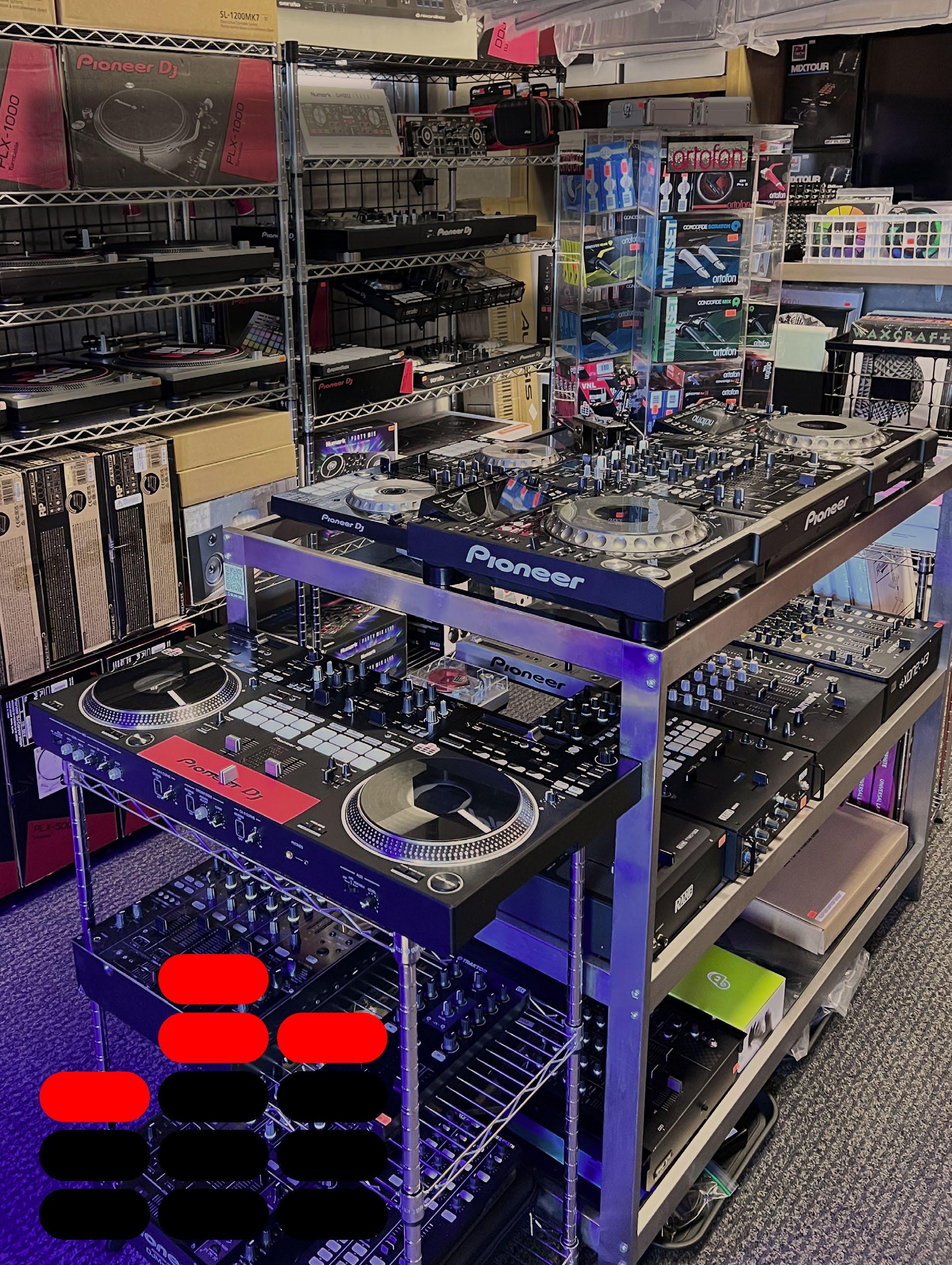


“Griztronics” (Deadbeats, 2019): A viral TikTok tune that took the bassmusic world by storm, this wonky collaboration with GRiZ is a mind-melting bass behemoth that’s simply in a league of its own because “Ooh, this sh*t be hittin’ different.”
“Scream Saver” (Cyclops, 2020): This relentless barrage of womps and wobbles encompasses everything the Subtronics experience has to offer.
“Gassed Up” (Cyclops, 2022): A colossal collab between the genre’s elite talents, this collaboration with Zeds Dead (feat. Flowdan) is a bonerattling beast drenched with a lethal dose of U.K.-inspired grime.
B.B.more artistically fulfilled creating a wide spectrum and range of emotions and feelings. It creates more of a universe to feel immersed in.
DJ LIFE: What was one piece of gear defined your sound early on?
Subtronics: Hmm, maybe a MacBook Pro? I barely use any outbound hardware. Honestly, probably [Native Instruments] Massive and later on [Xfer Records] Serum. I’ve always been a laptop plus headphones, or studio monitors kinda guy, nothing fancy. I’m a firm believer in using stock gear and creativity to find your own sound.
DJ LIFE: How has the bass-music scene, specifically, changed since you first emerged onto the scene? What’s better? What’s not as good?
Subtronics: Aside from the same Tweet that pops up every four months complaining about “how music used to be better…” [laughs], I think it is honestly quite similar. There are brief pockets of time where someone will drop something crazy innovative that shifts everyone’s perspective, but I think creativity-wise, it is about the same. The thing that’s different now is that it is way bigger and extremely saturated, which can go both ways.
DJ LIFE: How’s that?
Subtronics: Sure, there’s boatloads of boring, cookie-cutter music now, but

there is also even more insanely innovative, crazy risk taking, cutting-edge stuff than ever. Underground scenes in 50 different niches at once are thriving and coming up with crazy new ideas all the time. I would say the platforms to learn how to produce are infinitely better, and the platforms to share your work are ten-thousand-fold-times larger and better. That being said, things are overly saturated and you have to spend a lot more time sifting through less creative stuff, and it’s harder to be discovered among the sea of other very talented creator. There has always been the good and the bad – some kids will always say the scene sucks now, and there will always be people breaking down walls and writing big-brain, cutting-edge stuff. That’s just music and it’s all different perspectives. In my case, 2010 to 2015 is extremely sentimental, and that is for sure the case for everyone to their respective eras. Fans who got into dance music in 2018 probably feel the same way about music that came out around that time as I do about 2010.
DJ LIFE: What advice do you have for young DJ/producers?
Subtronics: The main thing is to never give up. It took me a decade to get anyone’s attention, and it was a slow crawl. Make sure with absolute certainty you are making music you love, because you love the music and nothing else. Focus on your weaknesses and improving them. If you continue to improve the things you are bad at, it is inevitable that you will eventually be amazing at it. Patience is key. Be nice to everyone. Kill your ego. Remove your expectations. Never stop working as hard as you can, but make sure that you are having fun along the way. Do not make music you think other people will like, make the music you like and the music you want to hear. People care about authenticity and can spot art that’s made to be sold from a mile away. You have to be genuine and it’s gotta be a sound you are truly and wholeheartedly passionate about.
DJ LIFE: What’s your approach to DJing? What’s in the booth for you?
Subtronics: So, I use four CDJs and generally double-drop most of my set. I get through about 80 to 90 songs per set, which can be broken down into routines. Most routines are chunks of two to four songs – I’ll use one of my own songs as an intro or one of my favorite classics, then it will drop into either one of my own songs doubled with another song, one of my own songs by itself, or
a mash-up of a bunch of different songs. I do my best to make this all happen live, hence the needing four decks.
DJ LIFE: How much of your set is your material vs. that of other artists?
Subtronics: I estimate I play about 40 to 50 of my own songs in a set, but 70- to 80-percent of my set is double-drops. I try to squeeze in all my main songs that people come to hear me play, while also playing new music I’m excited about, while also dropping the top-level exciting stuff that I personally love. To get it all in, most of my set ends up being a mash-up of a ton of songs at once, which means I have to get technical and mix extremely fast. It’s incredibly rewarding getting a big crowd response after all the groundwork that goes into each moment. Stylistically, I like to have a lot of peaks and valleys to give the big moments extra impact. So, it almost feels like a moderate to medium speed, but in order to execute all the doubles and mash-ups and stuff, I actually do have to go extremely fast on my end.
DJ LIFE: What are three tracks, not yours, that are always in your “DJ box” and why?
Subtronics: Phiso’s “Jotaro,” Bommer x Crowell’s “Yasuo ,” and Subfiltronik’s “Passout.” These tracks just double with everything. You can pair it with any song
and make that song better with it. I come from riddim – there will never not be at least one “DJ come with the tune!” in my set.
DJ LIFE: Do you prefer to spin at clubs or festivals?

Subtronics: I love small, dark, sweaty, basement shows and small intimate shows, in general. The energy is just so raw and you can communicate so effectively with the crowd. Festivals with great crowds are also peak existence. I love big productions with special effects like pyro, fireworks, etc., and giant audience roars. I like hitting both big and small shows on a regular basis, as they both come with their own pros and cons.
DJ LIFE: Which DJs do you admire?
Subtronics: When it comes to DJing, I would say Shiverz, Codd Dubz, and Skism are some of the best selectors and most technical DJs out there.
DJ LIFE: And music producers?
Subtronics: My all-time top three are Porter Robinson, Flume, and Skrillex… just the sheer amount of times they have reinvented their sound, while also completely flipping the entire scene on its head with new ideas and insane innovation. I look up to them so much. They have each created their own entire genre multiple times. Truly unreal. On the sound design and production side of things, artists like Noisia, Space Laces, Virtual Riot, and a literal mountain of up and comers such as BAW, Automhate, Leotrix, Cool Customer, and Imanu are all incredible.
DJ LIFE: What do you think of streaming in the post-lockdown world for DJ/producers?

Subtronics: I got into it during Covid, but didn’t really have time for it once touring picked back up. In order to really cultivate a fanbase, I feel like you need to be streaming constantly. I’m just simply not home enough to do it, let alone producing on stream feels like a lot of pressure, which isn’t the best environment to create in for me. It can absolutely be a great tool for up-and-comers though.
DJ LIFE: You’ve got some insane visuals for this ANTIFRACTALS Tour –where do they come from and did you have any input?
Subtronics: Thank you – they are definitely hugely important! The visual team is led by my guy Ray Elemento, who’s an absolute genius. He is an

incredible artist himself and also has a team of highly skilled artists that work together to create the vast majority of our visuals. Most of the concepts come from 5 a.m. brainstorm sessions between me and Ray. He has an insane ability to take even the most vague, random, abstract idea of mine and bring it to life.
DJ LIFE: Tell us about the sound system you used for the tour…
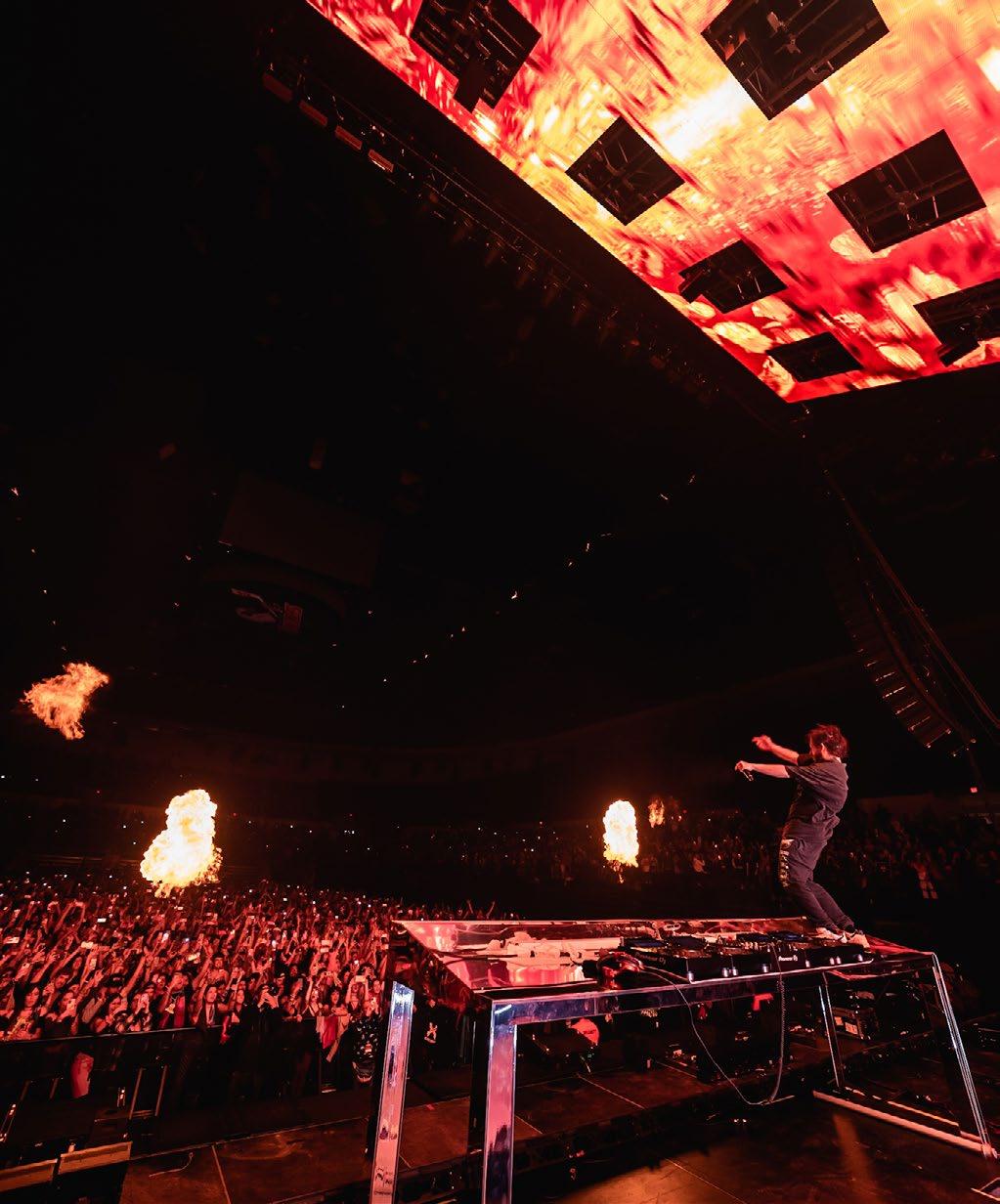
Subtronics: PK Sound! Ran by our dude Raurid, it absolutely slaps ungodly hard and is probably one the hardest-hitting, bassiest systems I’ve ever heard. I’m beyond honored to be playing on it every night. We’ve been knocking plaster off ceilings left and right.
DJ LIFE: There are many innovators in electronic music, but you’re in a league of your own when it comes to sound design. How do you achieve your sound?
Subtronics: Thank you! Means a lot. A huge amount of my sound comes from tonal delay automation, but frankly, it’s just hours and hours of automating dozens of parameters, dozens of post processing units, and dozens of layers of sounds… days and days of trial and error. It’s far less intentional as it sounds and far more just exploration until something cool happens. Lots of turning knobs endlessly until something peaks my interest, and then I just follow that thread. I trust my gut and excitement level, based off what I am hearing. I often say I have very little say in what I make – I just experiment and follow what sounds cool to me at the time.
DJ LIFE: What hardware and software do you use these days?
Subtronics: Ableton Live, Serum, Kilohearts, Kontakt, Omnisphere, Melda, FabFilter, Soundtoys, a whole bunch of random, small, boutique VSTs and stuff. I don’t really have any super-fancy hardware, just a Universal Audio Apollo soundcard and a pair of Barefoot 1 studio monitors.
DJ LIFE: You’ve always been open to collaboration with other artists. What’s the collab process like?
Subtronics: I always try to work with people who can bring something to the table that I cannot do myself, or isn’t my strength, and vice-versa. I like creating artwork collaboratively that we otherwise wouldn’t be able to do, but through teamwork, we can make something crazy and new. My process is the same as most others – we just pass stems back and forth.
DJ LIFE: You’ve made healthy diet and exercise habits a priority to close out
2022. Has it played a role in your creative process?
Subtronics: Mentally more than anything. The sheer amount of emotional stability is nuts. I haven’t really thought about how it’s helped me creatively, but I’m sure it is. There’s so much less stress floating around in my head, so I am able to focus on ideas better and get ideas out more effectively, all because my brain is a bit less fuzzy.
DJ LIFE: You’ve released plenty of tracks over the years, but FRACTALS was your debut album. What was the process like putting a 16-track album together?
Subtronics: It was the most effort I have ever put into one single release. I was trying as hard as possible to encompass my entire sound, the entire spectrum of artwork that I can make, and tell a story and to flesh out a vision as much as possible. It was extremely grueling, but incredibly rewarding. It took a solid two years, and in a way, is my entire effort of work from 2019 to 2021. I’d love to do it again, honestly.
DJ LIFE: Do you have a favorite track?
Subtronics: I cannot pick. “Spacetime” and “Into Pieces” stand out, at first thought. But honestly, they all do in their own way.
DJ LIFE: When it comes to label releases, what do you look for in a production for it to get a final Cyclops Recordings stamp of approval?
Subtronics: Something that sounds totally unique and different from the absolute waves of similar-sounding dubstep. Anyone that is putting true effort into innovating and making a new kind of sound. Clean mixdowns, also.
DJ LIFE: With 2022 now in the rearview mirror, what can fans expect from Subtronics in 2023?
Subtronics: Tons of new music, going to be exploring new ideas, while also revisiting old vibes. Big shows, more production and visuals, merch, but most importantly, once I am off tour, I am going to lock myself in my studio for a few months and knock out at least 40 to 50 unreleased tunes. I think I’m already up to 20 or 30 or so. A lot of really cool collab opportunities on the horizon. Very excited!
“THE MAIN THING IS TO NEVER GIVE UP. IT TOOK ME A DECADE TO GET ANYONE’S ATTENTION, AND IT WAS A SLOW CRAWL.”
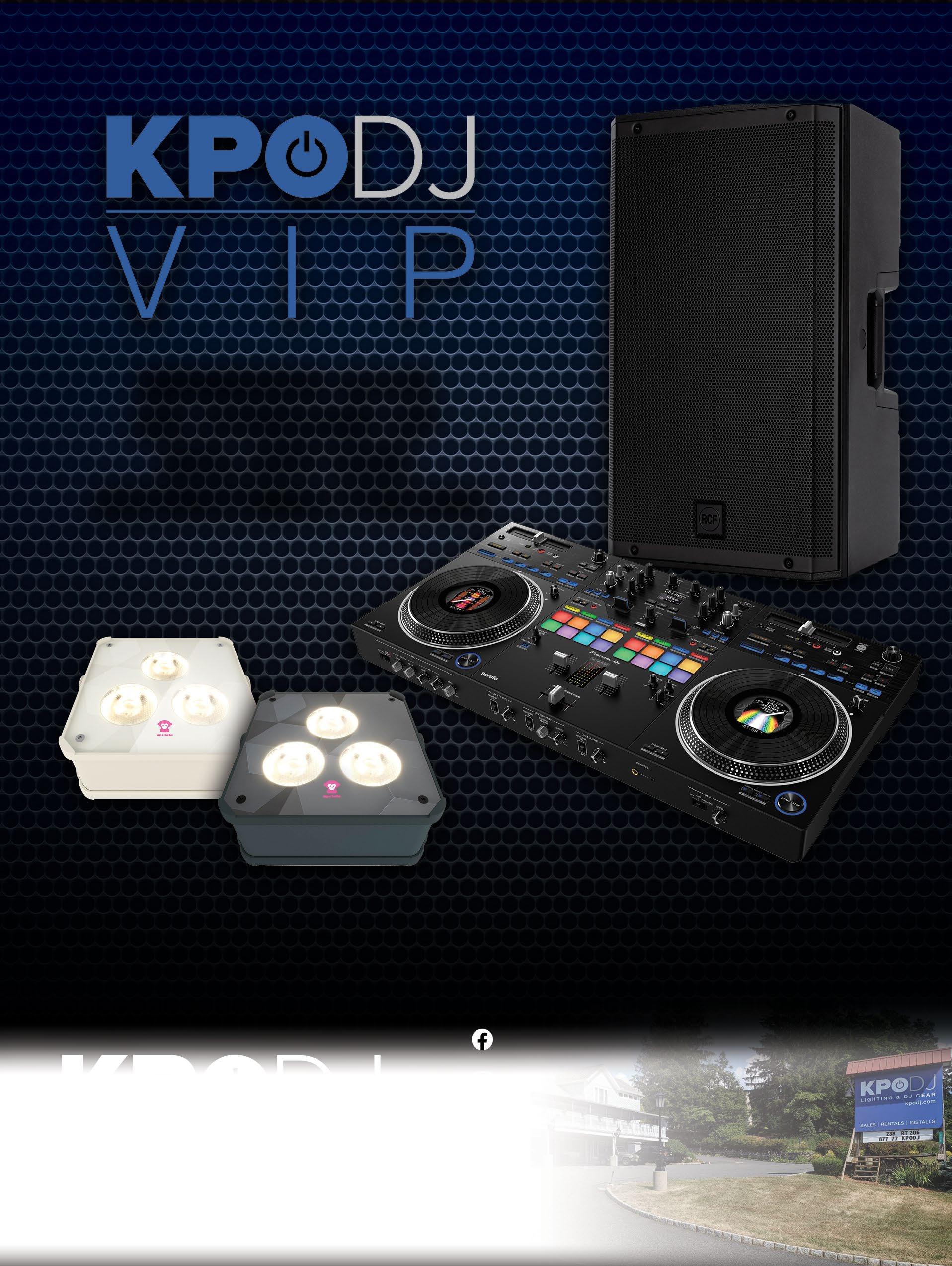

Miami, Fla. – Celebrating its 35th edition, the Groove Cruise Miami brought nearly 2,500 mad partiers aboard the Celebrity Summit ship this past Jan. 19-23 to experience more than 80 DJs spinning 96 hours on nine unique stages.

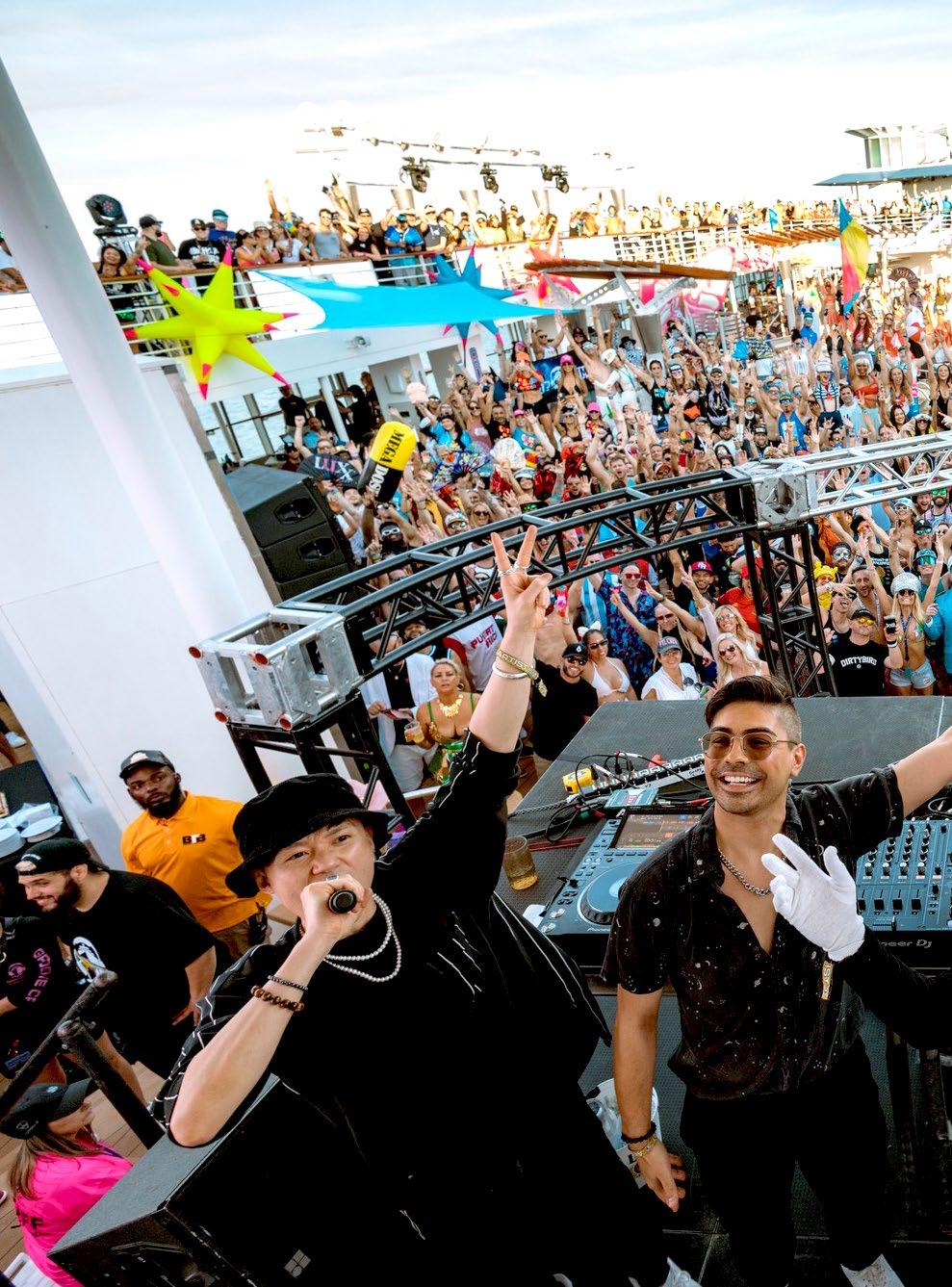
Presented by Whet Travel, the beat-filled, multi-themed party boat left the Port of Miami and traveled to the Haitian island of Labadee for beach parties and more. Headliners included Claptone, Jauz, Markus Schulz and Nora En Pure.

It all looked like this: (Images courtesy of The Groove Cruise):
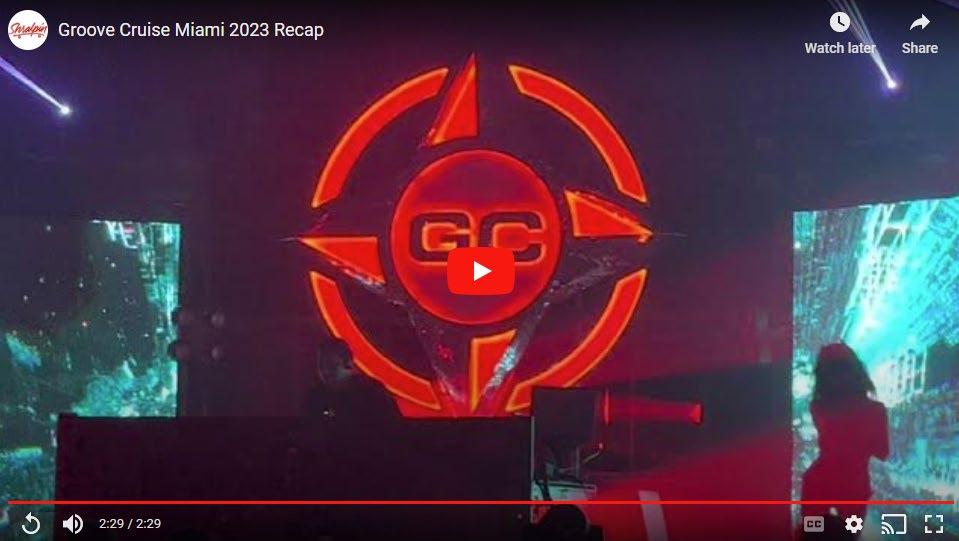
 All Aboard: Claptone & crew celebrate.
Ka-Boom: Blastoyz blasts off.
All Aboard: Claptone & crew celebrate.
Ka-Boom: Blastoyz blasts off.





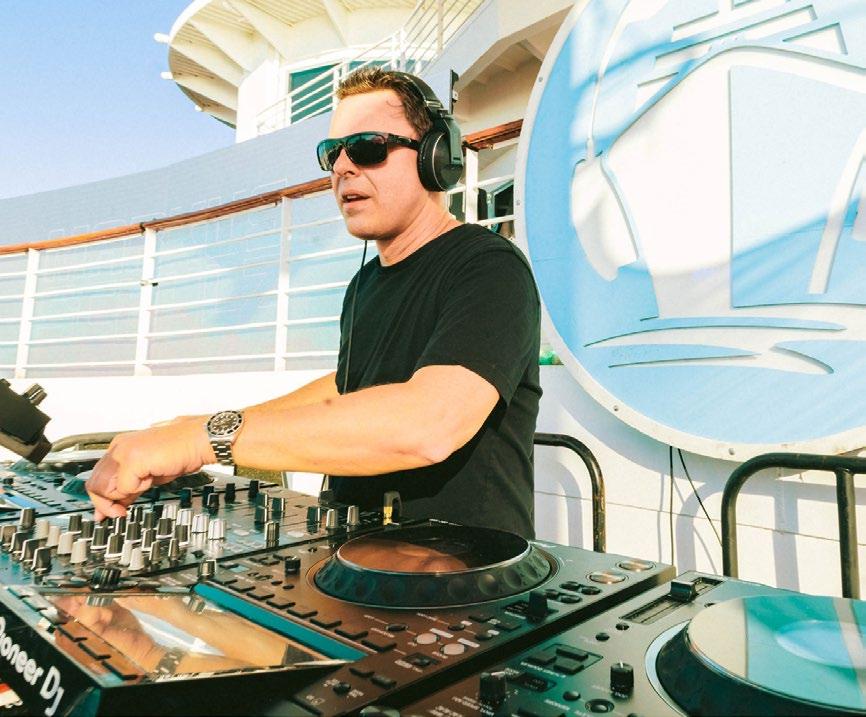
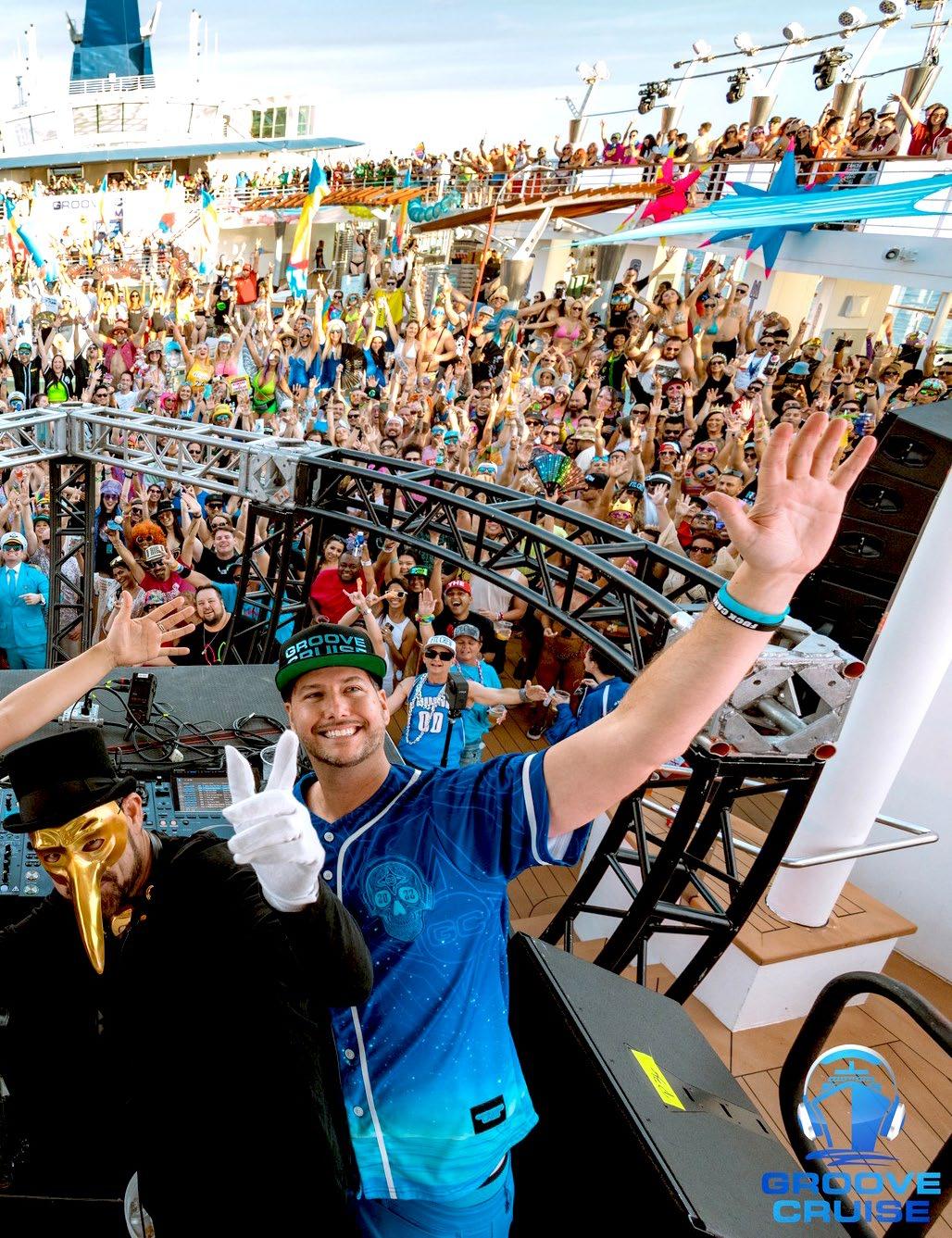


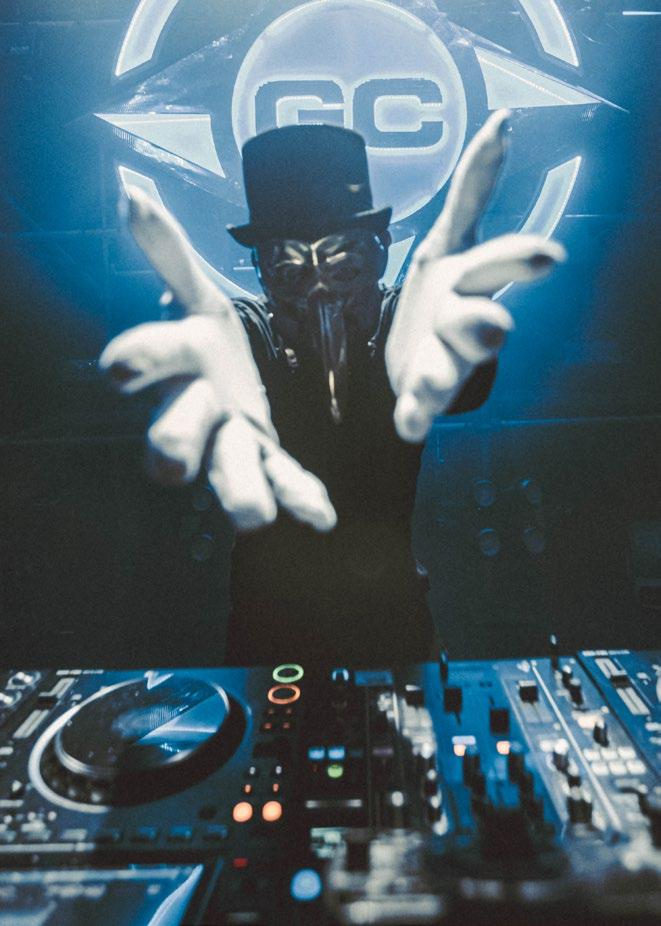
 Masked Marvel: Claptone, hands out.
Praise You: Trance Jesus with his flock.
Double Dose: Autograf in the mix.
Masked Marvel: Claptone, hands out.
Praise You: Trance Jesus with his flock.
Double Dose: Autograf in the mix.
please.




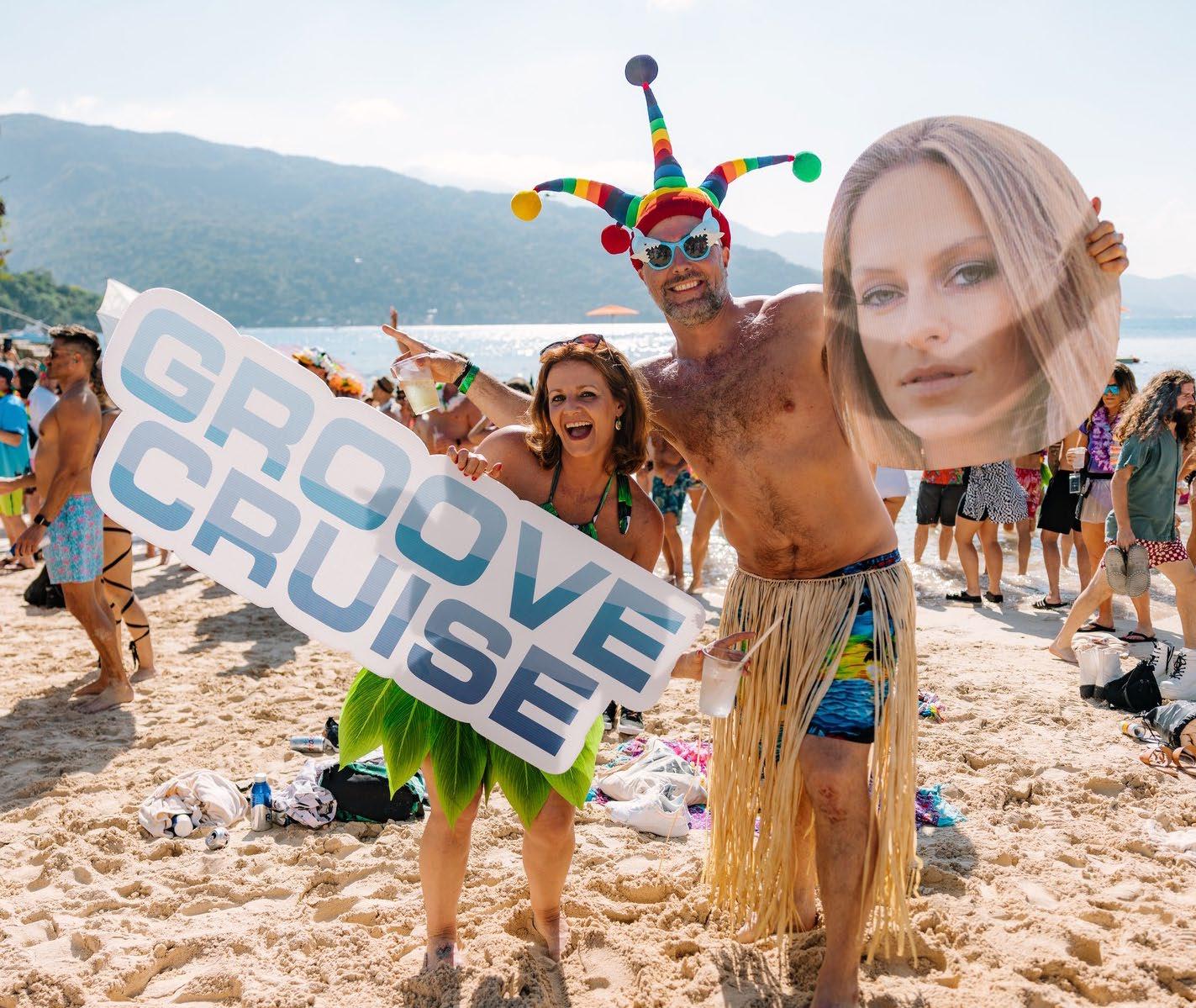 Sunset: End of another cruise.
Lights Out: Fairlane drops a beat.
Beach Scene: Nora En Pure fans.
Pizza Partier: No anchovies,
Sunset: End of another cruise.
Lights Out: Fairlane drops a beat.
Beach Scene: Nora En Pure fans.
Pizza Partier: No anchovies,
According to its nonprofit charter, Give a Beat’s mission “is to use the power of music as a pathway to healing and opportunity for those impacted by the criminal justice system.” Indeed, since its founding in 2014, the L.A.-based organization has offered DJ, music-production, and educational programs inside and outside youth and adult correctional facilities.
In 2019, it launched the Prison Electronic Music Program at two California State Prisons. In 2021, it began its “On a New Track” Re-Entry Mentoring Program, which paired formerly incarcerated persons with mentors in the music industry. This past year, in order to support people post-incarceration, Give a Beat Records was launched to give them a platform and share their voices. Its first release was geriFree’s “Pure Joy,” an uplifting house-music nugget; its second is Pelligroso’s “Street Poetry,” a gritty hip-hop track.
One notable supporter of Give a Beat is Eli Goldstein, one-half of the popular electronic DJ/production duo Soul Clap. In the course of his work with the non-profit, Goldstein (aka Elyte) met Russell Wardlow – a prison poet currently serving time in the Nebraska correctional system. Through one of Give a Beat’s related initiatives, the Prose of a Con radio series where DJs recited Russell’s powerful poetry online, Goldstein became impressed with and inspired by Wardlow’s work.
Now the duo has seen its distinct talents converge on a unique, new project, Insides Outed . Released on Soul Clap Records by WayOfLife (Wardlow’s artist persona), the album’s vocals were recorded entirely from the Nebraska State Penitentiary’s solitary confinement unit and ultimately mixed with productions from Goldstein and Taylor Bense at Brooklyn’s Hyperballad Studios.
The result is a nine-cut full-length brimming with touching and honest songs filled with regret and hope, patience and frustration, love and pain. It’s a statement of redemption, and one that further explores a question that Wardlow has asked: “If a man can become a monster, can that monster become a man again?”
In separate interviews, DJ LIFE connected with both Eli Goldstein and Russell Wardlow to discuss Give a Beat, recording the Insides Outed album (from which a rollout of remixes from Mr. V, Nickodemus, and Pontchartrain expects to be available later in the year), and much more.
The Producer: Soul Clap’s Eli Goldstein
DJ LIFE: First, why did you get involved with Give a Beat?
Goldstein: I had read a few books that opened my eyes to the prison systems in America, such as “No More Prisons” by William Upski Wimsatt and “The New Jim Crow” by Michelle Alexander. I learned that our criminal-justice system is designed to oppress black people and people of color in the U.S. So, I was aware of the problem and I happened to connect with Lauren Segal [of Give a Beat] at some point at a party about our shared interest in using the power of electronic music and culture for activism. She told me about Give a Beat and I pretty much immediately signed on to support the organization.
DJ LIFE: Obviously, recording the album with vocals from behind bars was a challenge. What was the actual process?
Goldstein: The process started with Russell recording these vocals over the phone from solitary confinement when everybody in his facility was put in solitary for a COVID outbreak. So, he recorded these nine a cappellas with Christie [Ninerell of Give a Beat] over the phone, and then they got sent out to a few of us who had been in contact with Russell.
At first, I listened to them how I listen to promos as a DJ, quickly flipping through music, and initially I thought they were cool, but really, poor quality audio. Some time passed, and then I was thinking about
Russell and decided to honor him by listening deeper. I lined them up with the beats that he had written the rhymes to, just free YouTube beats. Then, I could listen to the a cappella over the beats that he was originally listening to in his headphones while he was recording. And it started to really connect in my head and I was like, “Wow, this is really incredible.”
The quality being over the phone obviously is not ideal for recording. And that was the main reason why, originally, I was a little skeptical. But the emotion and the power and the depth of his lyrics came through, regardless of the media for recording. So, at that point, I was kind of like, “Wow, this is a body of music that is cohesive and we should put out as an album.”
DJ LIFE: What’s in your studio and how did you use the gear for this project?
Goldstein: The new beats were all produced and recorded by Taylor Bense at Hyperballad Studios in Brooklyn. He’s a producer that I’ve worked with a bunch over the years. He’s more on the electronic-music tip, but super-talented musically and in the studio – and I knew we had a shared love of hip hop. Everything was recorded on Ableton Live with a slot of samples and plug-ins, but also a few synths and samplers and drum machines.

DJ LIFE: Obviously, there’s an intensity to Russell’s current situation and his ongoing struggle. From your point of view, how did he convey that into compelling artistic expression?
Goldstein: Russell has been writing prose and poetry for a long time – I think close to a decade – but the rapping is more recent. And so, he’s already a wordsmith. He knows how to use his deep vocabulary, metaphors, alliteration, all the important tools for a skilled MC. But what really, really grabbed me on this project was the raw emotion of his vocals. Each song kind of touches on a differ-
ent subject, and goes into depth on his experience related to that in a super-eloquent way. But what really pulls you in deeper is the emotion. He is able to use his experiences to capture universal feelings and understandings and paint a picture with words. It just really, really brings you in.
DJ LIFE: Obviously, you’ve had more experience than Russell in making records. Was there any artistic back-and-forth between you two?
Goldstein: It’s really hard to have artistic back-and-forth when you’re not in the same place, and even harder when one of you doesn’t have the normal freedoms of a musician to create. Russell and I get to talk at most a couple of times a week for short periods of time. There was a system that we could use to email each other, but earlier this year
they switched the systems in the prison and the email got way, way worse. So, it’s much harder for us to communicate via text and email at this point, and just a reminder that all these systems are set up by private corporations – all for profit, right? So, any communication you’re having with somebody in prison in the United States, somebody’s making money off that, a corporation is making money off that communica-
tion. That’s just insane.
But we were able to talk a bunch and share ideas. And we generally talked a lot about his artistic ideas and process, and I give him feedback and direction. It’s really hard, though, with not being able to share music to inspire each other. That’s something I can’t really do. So that’s something that’s going to really be an amazing step when he does get out, to be able to share our inspirations and musical directions. A lot of this specific collaboration came from the beats he chose originally, and the quality of his vocals, and being able to kind of tap into that and try to recreate the feelings of those beats in new ways that connected with his voice and with his lyrics and his emotions, the vibe of the tracks.
Then obviously sharing the music with him, when it was recorded, was incredible. There was this moment… he’d never actually heard his voice on the song before. So, the first time I played something back, the first beat with his voice on it, you know, was just like this super-emotional moment for both of us – and that was really special.
DJ LIFE: On the hip-hop side of things, which producers do you admire and why? Did you and Russell have a conversation about how this record would sound?
Goldstein: Russell’s of the kind of newer generation, mostly influenced by trap – whereas I grew up in the ’90s. So, I was really influenced by that Golden-Era hip hop like A Tribe Called Quest, Gang Starr. DJ Premier is one of my favorite hip-hop producers, if not the top. But all that jazzy stuff from the mid to late ’90s when I started DJing is really important to me, too, like Hi-Tek and Shawn J. Period. And the more instrumental beats by DJ Shadow and Dan the Automator were big influences for me growing up, too.
More recently I’d say Terrance Martin, who produced the Kendrick Lamar To Pimp A Butterfly album, is a major influence because he’s super funk and jazz. And then all the G-Funk and adding funk to hip-hop beats is really important to me, too.
For me, that’s part of why this has been a really interesting experience, learning more about how trap beats are produced. It’s not like we just made a trap album for Russell, right? A lot of it was bringing in our influences. There’s trumpet and guitar and Taylor was able to bring his musicianship to this as well. We had our longtime collaborator Greg Paulus on trumpet on one of the songs. Bringing in our [Soul Clap] sound, but we’re trying to make it modern in a way that’s connected with Russell’s.
DJ LIFE: As Soul Clap with your musical partner Charlie [Levine], you make great electronic-dance music and you play amazing parties and festivals – so, you see the very hedonistic side of dance music. But this record is a very different kind of endeavor. Do you think we could see more socially conscious efforts from DJs and dance-music world?
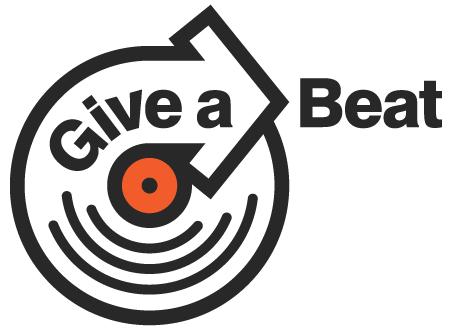

Goldstein: Yes, we need to see more socially conscious efforts from the dance-music world! House music and techno were born as subversive music for marginalized people. It is the heart of the music culture, and an essential element that producers and DJs should be exploring and understanding, if they want to know the history. They should try to understand how they can also make a positive impact on the culture and the world as well.
I’m also very involved in climate work through electronic music with an organization called DJs For Climate Action. There is actually a lot of work happening across the industry for climate and the environment, as well. We also helped organize a get out the vote initiative called Rave That Vote with a number of artists, our management company 2plus2, and Infamous PR. This is something that goes hand-in-hand: music, politics and activism. They are connected, they are inseparable. Thinking about American music and the 20th Century – from jazz to folk music to hip hop and disco – it all has a social-activist streak at its heart.
For me, it’s an easy transition over into something that’s more thoughtful, political, and thought-provoking. And that’s something that me and Russell talk about a lot is the power of music and, especially the power of his music, because he’s so talented with words and can reach people in their in their hearts and their minds.
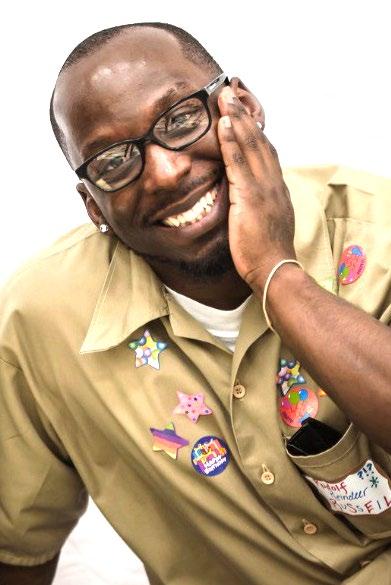
DJ LIFE: What are your earliest musical memories – the ones that stuck with you and influenced the music you’re making now?
Wardlow: I’m relatively new to music, so I didn’t do anything besides playing around, free-styling at high school. My friends were the actual rappers; we used to do this concept and chorus that went like, “What would you do for a Klondike bar?” Then some beatbox and we rap that subject... I was sorriest!
DJ LIFE: Did you have favorite MCs and producers?
Wardlow: Lil Wayne, his song “I Feel Like Dying” was an ethereal moment for me… then, of course, his mix-tape craze. Cassidy’s smooth battle-rap-like punchlines, Jadakiss’ raspy delivery and metaphors, Lauren Hill’s everything, and fast-forward onto Chance The Rapper’s first SNL experience. I finally made sense of it. He put all of those people into one and added himself – to me, that made WayOfLife
DJ LIFE: At what point did you devote yourself to poetry, lyrics, and music? What motivated you?
Wardlow: In 2017, I asked my friend Katie [Cox]: If a man can become a monster, can that monster become a man again? I reflected on the fact that I could die in prison or get life in prison. I wanted something, so my sons could know who I am. Everyone told me I could write and rap, but I thought nothing of it. One day Katie asked me, “Russell, when’s the best time to plant a tree? Twenty years ago. When’s the second-best time? Today. What are you waiting for?” I became a poet, Kobe died, and I became a rapper. I rapped, “Even heroes can die while you’re alive, so I gotta make it all count…” so, Mamba Mentality! I put the work in and found many styles, keeping my sons at the forefront of all of it. Every line is me clawing my way to them, defying these walls.
DJ LIFE: Tell me about the process of putting this record together with Eli.
Wardlow: The process was more like a see-saw adventure – my turn, then his turn. Prison comes with many obvious complications, so Christie recorded all the vocals, and Eli and Taylor listened and composed/produced all the sounds to make the music. I’ve heard some early ideas and a couple finished products, but it’s mostly been a mystery, expected in my position, but a reality I have to accept in order to move forward and create.
DJ LIFE: What kind of artistic statement were you looking to make?
Wardlow: I wanted to show the entirety of different feelings of a prisoner and to transcend the limitations. We live in a world within a world, so we feel and hear everything, but see nothing – yet no one hears, sees or feels us.
DJ LIFE: In your songs, I hear lyrics that have deep regret, but there’s also hope. There’s love for your children. There’s self-determination. There’s a sense of patience, but there’s also frustration. It’s your life. Can you tell me about how these lyrics came to mind?
Wardlow: A convict is the embodiment of regret, hope, self-determination, frustration, and impatience at all times. We can’t separate ourselves from those concepts. We don’t speak them; we become them, and yet we manage in order to exist, survive and fight for something more – or succumb to just that. Internal and external turmoil is our soil and oil; it fuels us and we grow in and from it. I didn’t think the lyrics – they just came out, like air is exhaled.
DJ LIFE: How does your situation help or hinder your artistic process? Is there a time when you are most artistically focused?
Wardlow: Prison became college and a hyperbolic time chamber. It presented me the opportunity to become something more in my isolation, but it fights that evolution every chance it gets, forging it with a continual fire of obstructions. The phone can only do so much for delivery and nuance, and the limited time to reach out creates obscurity, but imagination thrives in darkness.
DJ LIFE: These days on the outside, there’s a lot of political hay being made about crime and what to do about it. Less effort seems to be made about actually preventing it or helping those caught up in the system. What do you say to people on the outside about people on the inside? What should they understand?
Wardlow: Crime can only flourish in a country so “great” and developed as America, if it allows for it, if its culture creates and feeds off of it. When education and resources come with disparities, crime is the variable. You can only do with what you know and what you have. Look in the mirror. We are exactly what you refuse to see and what you do see. One moment creates a conditioning of moments when true understanding and help isn’t given. Empathy shouldn’t be an incentive; it should be a condition of a person’s heart. We are hurting, and trying to heal. Isolation in the form of alienation and ostracism can never be an answer to develop a human’s heart and soul. It corrodes the mind and spirit and callouses the heart and emotions. The Constitution’s 13th Amendment must change and crime cannot fatten pockets for change to be real.
DJ LIFE: Thanks, and good luck – anything else you’d like to add?
Wardlow: This is only step one. I am many – that’s why my name is WayOfLife. This is the beginning of a Black Sheep Movement. We can’t keep being spoken for and believe we’re being heard; we have a collective responsibility to provide shoulders to stand on so more can be seen and therefore fathomed and dreamed. Emotional, relational and spiritual healing is our need. My sons Josiah “Juice” and Treyvan “WayOfLife, Jr.” spirit my motor, and even at the lowest and darkest, you can resurrect, rise, and become more.
The MC: Russell Wardlow aka WayOfLife.— HERE’S HOW TOP MOBILE DJS HANDLE THEIR BUSINESS CHALLENGES
By Stu KearnsOwning a mobile-DJ business comes with unique challenges. Are you an entertainer first — or are you a business owner? If you want to expand, how can you make a carbon copy of yourself?
As a DJ-business owner, one thing you do know is that every gig is an opportunity to showcase what sets you apart from other DJs in your area. It’s an idea that has Scott Siewert of Full Tilt DJ’s & Photo in Madison, Wis., says provides professional fuel.
“I have been in business since 1981, and the two keys to staying in the game this long is to always exceed expectations of the client,” says Siewert “Always put 150-percent of your heart and soul into, not only the production part of your performance, but also the other things that the client doesn’t see. Be nice to people. Make sure they know you care. Lastly, surround yourself with great people that are supportive.”
One of the best ways to stand out from other mobile DJs in your area is by offering something new and different. This could mean providing additional services, such as karaoke or creating custom playlists for each event. It could also involve investing in high-quality equipment that will make your sound system stand out from the crowd.
Offering unique packages and bundles can also help you differentiate yourself from other local DJs, while still offering competitive prices that will keep customers coming back for more.
Or it could mean providing bubble parties, like Mike Wieder of Ultimate Sounds Entertainment has been doing for the last few years in New Jersey.
“With bubble parties, I have more avenues to go for as well as more dates to fill,” says the East Windsor-based Wieder. “I can work every day of the year if I want, while in the DJ world the majority of events – weddings and mitzvahs – are on the weekends.”
One challenge many DJs face is expansion — how do you duplicate yourself? The answer is training, or what Chris Bartosik of Raptor Productions in Baltimore, Md., says are the three S’s — Scaling, Staffing and Stress.
“When you’re building something, it’s so much bigger than one or two people,” says Bartosik (aka DJ Raptor). “You need to develop talent. You need to find ways to encourage growth, while respecting the differences we all have. You have a huge responsibility when you onboard employees. You have to consider every decision you make and how it affects others. Are you making the right investments? Are you scaling too quickly? Can you support the workload you’re carrying?”
Another way to expand is to merge with a like-minded competitor. That’s what Chris Hintz of Pinnacle Productions in Sioux Falls, S.D., did in 2014.
“Jeff Meuzelaar, the owner of Musical Edge, and I had known each other for a couple years, had developed a friendship, and worked together in a couple different events and ventures,” says Hintz. “The thought process was to develop a deep talent pool to be better than one or two deep. In the multi-op world, it seems like there is one superstar and a bunch of subordinates.”
Hintz says Meuzelaar (aka DJ Kor) is “insanely talented in marketing, social media, and web, and he’s an incredible promoter and has developed relationships on a national level, doing very high-end events for some very high-end clientele.”
Meanwhile, Hintz’s strengths are in the financial sector of the business, networking, and connecting with the bridal and corporate markets. In this case, the ongoing collab has worked out well for both parties.
In order to generate consistent bookings, it’s important for mobile DJs to have a strong online presence with social-media accounts like Facebook and Instagram. Most important is a website where potential clients can learn more about their offerings and book events quickly and easily.
Alan Chitlik of Seattle’s Puget Sound DJ has lead-generation forms on his website.
“My website is designed to give my couples lots of information about me and who I am and lots of quotes from couples about what was the impact of working with me on their wedding,” he says. “The amount of information might be a turn-off to some people, but the people who stick around can learn a lot.”
Most of Chitlik’s leads come through these contact forms. “My goal is to answer that inquiry as soon as I can,” he says. “In that initial interaction, I’m hoping to get them to agree to a phone call or video chat. In that case, if it goes well, I’ll suggest grabbing coffee for a more in-depth discussion.”
And when does he answer the price question — the “how much do you charge?”
“I will answer the price question directly whenever they ask it or whenever it comes up,” says Chitlik. “My couples have told me pretty consistently that I’ve offered good value for the impact that I have on weddings, so I don’t shy away from it or make couples go through a lot of hoops to get a price.”
Of course, another challenge that many DJs face is the idea of stopping what they love. Many DJs can’t even conceive of a time when they’re not making an impact on their clients’ most special days.
“I would love to continue as long as I enjoy it,” says Bartosick. “Since I’ve already started bringing in other DJs, I would hope to continue on that path and be connected as long as possible. Years ago, I started putting money away for retirement, and I continue to do it monthly. I would love to do this forever, but I know at some point I’m just not going to be able to.
“Many older DJs I’ve met along the way are still doing their thing, but among their peers. I have a couple of friends that are still doing events in many senior-living facilities. Of course, their gear is much smaller and portable and they really don’t need all the ‘fancy DJ toys,’ just some good music. Until then, I’m going to surround myself with great supportive DJs, as we all continue to travel down our paths.”
Challenge accepted!
Pattaya, Thailand – Held this past Dec. 15-18, Wonderfruit played host to 25,000 attendees and delivered a whopping 92 hours of music at The Fields at Siam Country Club in Thailand’s Chonburi Province.



The lineup consisted of 70-percent electronic music with both live and DJ sets from the likes of Craig Richards, Âme, DJ Tennis, Nightmares on Wax, Sebastian Mullaert, and Mount Kimbie.
Although the Wonderfruit gathering’s organizers eschew the term “festival” in its description, the event certainly curated an eclectic selection of music. And, as always, Wonderfruit offered plenty of workshops, group activities, and diverse food choices –and it maintained its environmentally-centric focus.
Thursday started kicked things into motion with Bangkok-based German talent Shir Khan, who set the mood with an infusion of melodic techno and house. Howie B then rocked the Neramit Stage with some U.K. breakbeats, which got the crowd going.
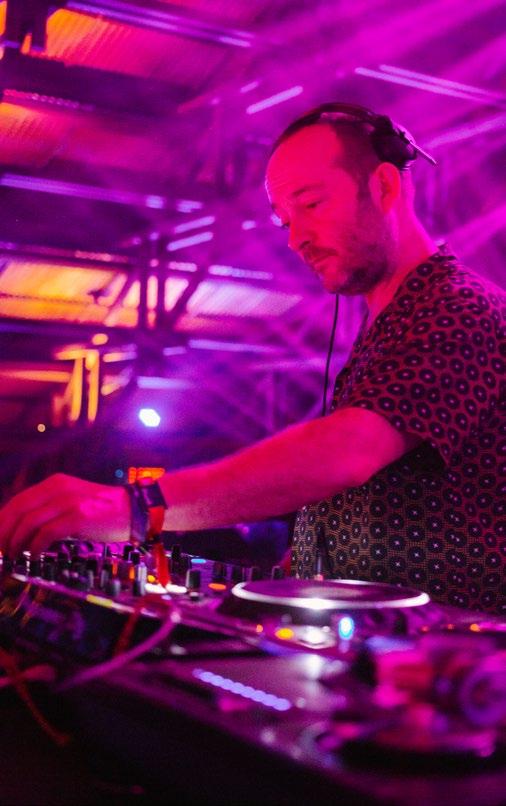
At the Solar Village at sunset, Tom of England dropped an array of beats, including Floorplan’s rollicking “Right There.” Afterward, Berlin-based Mexican producer Robbie Akbal drew quite a vibrant crowd with an eclectic set at The Ziggurat Stage. At Polygon, Photay performed an energetic live set to a primed audience before Craig Richards closed out Friday night at Neramit.
Saturday morning saw the likes of Mamazu spinning at Polygon and Ouissam playing at Forbidden Fruit. With his right mixture of harmonies with house and techno beats, Kai Campos of Mount Kimbie spun an astounding set at Neramit. Then, in the Quarry, Ben UFO delivered a thrilling set before a massive crowd.
Sunday morning started what turned out to be the best day of music. DJ Nu-Mark, Dan Buri, and Elektro Guzzi got things warmed up before Romain FX began rocking the Ziggurat Stage. Other standout sets included Shir Khan and Craig Richards at Forbidden Fruit, Nick The Record at the Neramit Stage, and Âme live at Polygon.
At Forbidden Fruit, Nick The Record dropped a tasteful array of house before Circle of Live (with Sebastian Mullaert, Frank Wiedemann of Âme, and Kai Campos of Mount Kimbie) played a mesmerizing six-hour set at The Solar Stage – a mind-blowing mix of synths and Ableton Live. Afterward at the Neramit Stage, Nightmares on Wax rocked a huge, hard-dancing crowd. Then, DJ Tennis closed out the event festival at The Solar Stage – to much applause. It all looked like this:


Top (L to R): Nirvana: Wonderfruit had 92 hours of music. Tech-House: Craig Richards works the crowd.— Sunset Gathering: Fans get into the groove.

Above (L to R): Sweet Beats: Nightmares On Wax at Neramit. Ziggurat Stage: Robbie Akbal rocked the joint


Below (L to R): Eclectic Mix: Wonderfruit offered bands & DJs. Late Night: Crowd gathers for evening beatfest.

 By Wesley King
By Wesley King
Since recently reviewing Ableton’s new Note app for iOS and iPadOS, I’ve been greatly enjoying the ability to tinker around with musical ideas and concepts on the go. I’ve found that it’s not such a bad thing becoming untethered to the darkness and crushing quiet of my home studio, which is in a room situated in one of the corners of the garden-level basement of my home. Being down there has always felt like it’s more amenable to the serious, focused work of mixing and mastering than letting creativity flow freely and easily.
But moving out of the studio with Note, Garage Band, or similar apps has had its challenges. As much as I like the fidelity and privacy of a “personal listening device,” such as IEMs or a classic set of studio headphones, having your ears plugged or covered has both advantages and disadvantages – and I don’t really always love the feeling of being “wired-in.” It honestly just feels like it’s one more way of interfering with the creative flow. But you can’t just have a set of studio monitors with you everywhere you go. Or can you?
That’s the promise of KRK’s new GoAux 4 studio monitors: A compact, good-sounding pair of decent speakers, designed specifically for use in creating music anywhere the mood strikes.
When you unbox the KRK GoAux 4 set, you’ll find everything nicely packed into the system’s included carrying case – a lightweight, padded nylon bag with a carrying handle and detachable shoulder strap. There’s just enough room for everything to fit snugly inside, although it may be somewhat telling that some of the cables are hiding in the external side
pocket of the case, rather than inside. My one complaint: It’d be nice to have just a tad bit more room inside for cables, bits, and bobs.
The speakers themselves are compact and of a typical KRK design, sporting main drivers with the company’s trademark yellow driver cones. While most studio monitors come without grilles, given the portability and need for ruggedness, the GoAux speakers do have sturdy, integrated grilles over both the main driver and tweeter.
At the risk of denigrating the product, the GoAux 4 system has a computer-speaker-like design. By that, I mean that one of them (the left in this case) has the amplifier circuitry, connection points, and power plug, while the other (the right) is merely a remote. This makes sense, given the use case. The alternative would likely have been heavier, for one, but also less easy to make the audio connections and would require a second AC outlet, too.
Those connections are more flexible than I’d have expected. From an 1/8-inch stereo plug to dual RCA to dual ¼-inch TRS, you’ve got options. Moreover, a USB Type B connection is provided that can be connected directly to a computer and acts like an audio interface. Like the game-show announcers used to say, “But that’s not all!” There’s even Bluetooth on board (more on that below). Note that cables for the connections to your computer, tablet, phone, etc., are not provided; pick what you prefer, and toss that into the pocket inside the top panel of the bag.
The design of the speakers themselves consists of the main cabinet enclosure, with an adjustable tilt base that easily attaches to the bottom of the enclosure and allows you to point them toward your listening position for optimal quality.

The attachment is done with a threaded knob, much like the one on a typical camera tripod. My one complaint about this is two-fold. First, the knob has no U-clip to “capture” it in place on the base, so when unfastened, the knob has to be stowed somewhere, and I’m afraid of dropping or losing one of them. Second, a nice touch would have been to design the carrying case so that the units fit inside with the bases attached. Alas, they must be removed to be put in the case.
Finally, KRK has provided a nifty feature: automatic room correction. Much like home-theater systems, set your speakers in place, plug in the provided correction mic, position it at your listening position (where your ears will be), and press the ARC button on the back of the left speaker. A series of tones are initiated, and EQ will be set based on the results of the test.
Of course, you can easily set the LF and HF EQ levels manually.

One thing I loved about KRK’s rollout of the GoAux 4 is that they chose to shoot a video for the product and its intended use cases featuring — wait for it — a produc ing DJ. Paul Blair (aka DJ White Shadow) was shown traveling with and using the GoAux 4s, and frankly, I share a lot of his enthusiasm for the product. As he says in the video, using them instead of headphones allows you to get up, move around the room, experience the music in a more natural way, and even allows you to share the experience with others nearby for a change. (Just be mindful of your neighbors in adjacent hotel rooms, I suppose!)


Subjectively, the KRK GoAux 4 set sounds good — really good — which is what I’d expect from a product with that cool KRK logo sitting on the front. But to bring this back down to earth, it’s important to manage expectations, too. With a 4-inch driver, a speaker can only give just so much low-end.

But the GoAux product isn’t intended for final mixing or mastering. It’s built for composing, ideating, and collaborating on the go, and for that, you don’t need a 15-inch subwoofer’s worth of low-end. What they do offer is frequency response at –3 dB SPL of 65 Hz to 20 kHz; the actual range of reproduction is slightly wider than that, just at a lower SPL.
Finally, for general listening, the onboard Bluetooth is a really useful and hassle-free thing to have available. Be aware, however, that the wireless connection does introduce enough latency to be both noticeable and problematic when doing anything other than general music listening. For actual production work, you’ll definitely want to use a cabled connection, the simplest very likely being the plug-and-play “USB-as-an-audio-interface” route. It’s class-compliant (no drivers needed), and that means you only need a single, common, easily replaced cable to hook things up in most situations.
As usual, KRK has packed a lot into a small package with its GoAux 4 system. It’s relatively affordable (about $420 on the street for the set), ready to take with you nearly anywhere, and provides a ton of flexibility to do your thing wherever your travels might take you. Hopefully, a future “V2” of this product will address the capacity of the carrying bag, and let you just keep the bases attached to the cabinets. But even without such improvements, the KRK GoAux 4 solution is a nearly perfect one for modern music production on the go.

With wind chills dipping below minus-30 and meteorologists using words like “bomb cyclone,” my DDJFLX4 review unit from Pioneer DJ couldn’t have arrived at a better time. Whether I liked it or not, given the weather, I was going to be a bedroom DJ – and, as it happens, that’s quite possibly the target audience for this nifty, new controller.
A Little Background: The FLX name first appeared on Pioneer DJ’s 4-channel DDJ-FLX6, and the FLX4 borrows a few design elements from its larger sibling. It’s also similar to the company’s popular DDJ-400, but it takes things in a different direction from the turntablism-oriented DDJ-REV1.

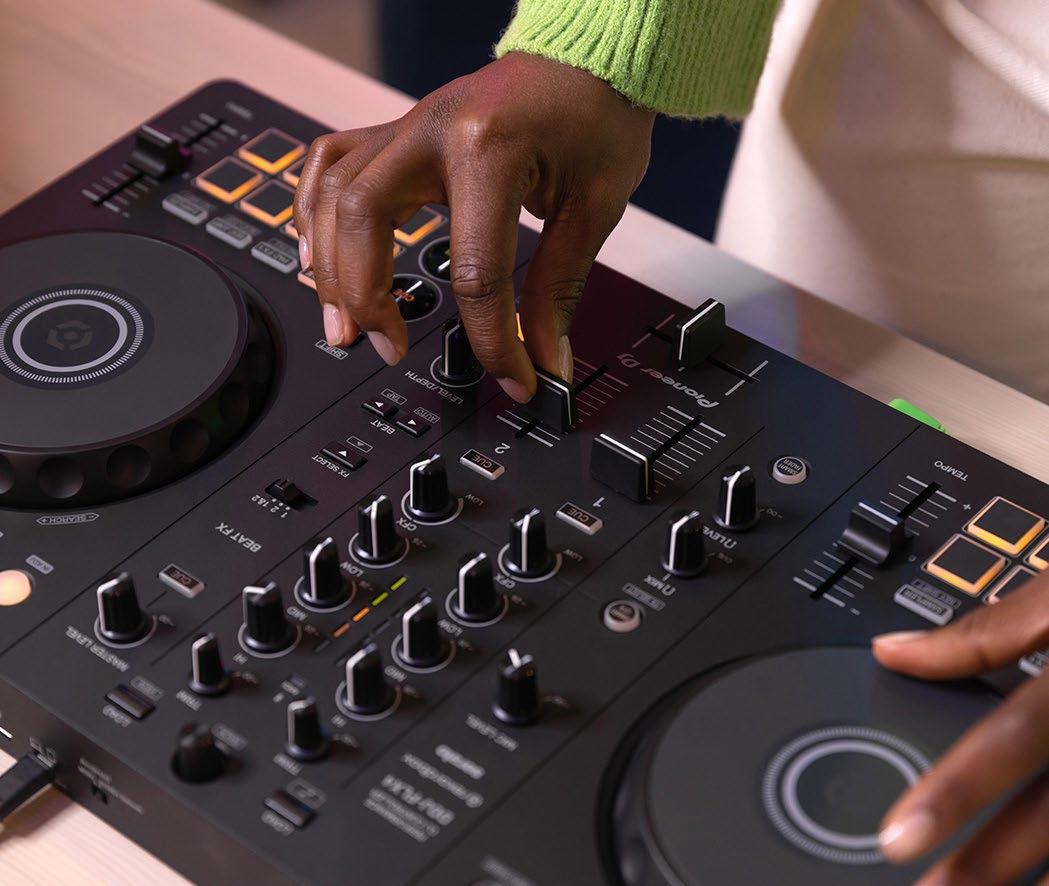
Layout & Features: The DDJ-FLX4 controller is constructed out of plastic, and – although I wouldn’t put it through a torture test – it seems sturdy enough for frequent home use and occasional gigging. The layout is typical controller fare: two deck sections flanking a central mixer section. Each deck section has a 4.4-inch jogwheel – the wheels feel acceptable, maybe with a touch too little resistance for my taste. Missing are any jogwheel displays, like those seen on the larger FLX6 or the rival Numark Mixtrack Platinum FX.
Above the jogwheels are CDJ-style looping controls and a sync button. The looping controls will be familiar to anyone who has previously used Pioneer DJ’s classic CDJs or other Pioneer DJ controllers. Below the jogwheels are transport controls, eight performance pads, and the pitch slider. The rubber performance pads are on the smaller side and click when pressed. I never found them to be too small, and I’m especially happy to see them included on a controller of this size. I especially can’t complain, given some other controllers in this segment have even smaller pads. The pads can toggle between hot cues, pad-based effects, beat jump, and the sampler. I’m happy to report the pitch slider has a reassuring click when centered, which I’m a big fan of.
The mixer section is straightforward and easy-to-use. There are two channels, each with line faders, 3-band EQs, a sound color effect knob, and a trim control. The line faders and crossfader are nothing crazy, but they get the job done just fine. The sound color effects knob can work as a combo high/low-pass filter or can be assigned to other effects in the software.
There’s a “Smart CFX” mode, which adds a bit of extra pizazz to the usual high/low-pass filter by combining it with other effects. That being said, I was surprised to see the sound color knob identical to the regular EQ controls. I prefer when the filter knob has a different shape or texture than the regular EQ controls. This allows me to quickly know what knob I’m touching, based on feel alone. Thankfully, the trim knob at the top is skinnier than the rest of the EQ controls.
Above the EQ section, there is a small knob for browsing through playlists and two load buttons for
each channel. The left side of the mixer has controls for the microphone level, headphone cueing and vol ume, and a button for activating the “smart fader” feature (more on that later).
It’s really cool that the microphone input feeds through to the USB, meaning mic sounds can appear in recordings. It seems like this is becoming the new standard for controllers, as recording mixes for posting online becomes more popu lar. The left side of the mixer has the master level control and the effects section.
Admittedly, the effects section here is a little sparse. There is a switch that can assign the effects to either channel or the master, two buttons for changing the beat settings, a single effects knob, and an on/off button. By contrast, Pioneer DJ’s similarly-priced DDJ-REV1 takes things to the next level by triggering effects with spring-loaded paddles.
At the front of the unit, there is a single headphone connection on a headphone jack (1/8-inch connection). I, personally, like to have both sized headphone connectors, as this allows someone else to simultaneously listen to the cue output if I’m playing back-to-back. If I bought this unit, I would definitely invest in a separate headphone splitter so I can have the same functionality.
On the back, there is a single master output on RCAs, an unbalanced TRS mic input, a connection for a Kensingtonstyle lock, and two USB Type-C connectors. When the unit is plugged into a laptop, it draws power from the laptop. However, there is a second USB Type-C connection for power only for situations where the controller is plugged into (or connected wirelessly through Bluetooth) a smartphone or tablet.
Full smartphone functionality through the upcoming rekordbox mobile app is set to be released in a few months, and connection via MIDI Bluetooth will be possible. I personally prefer the peace of mind that comes with having my hardware directly plugged in through a wired connection, but it is a cool feature. Interestingly, this is one of a handful of DJ products that uses USB Type-C instead of the usual USB Type-B. USB C ports are much smaller than USB B ports and are becoming more popular, so I wouldn’t be surprised if more pieces of DJ hardware end up using USB C connections. Pioneer DJ’s DJM-S5 battle mixer is another notable example.
In Use: The controller works out of the box with Pioneer DJ’s rekordbox DJ and Serato DJ Lite; it can be upgraded to Serato DJ Pro with a subscription. On both platforms, it performs exactly as expected, and


When activated, moving the crossfader from one track to another automatically adjusts several parameters – including BPM, volume, and amount of bass – to facilitate a smooth transition. In my testing, I found it more of a cryptic gimmick than a real game-changer. Personally, I preferred to just mix tracks than hope the algorithm has a goodsounding plan figured out. Having said that, I could see some DJs finding use in the Smart Fader feature if they need to quickly change songs without a transition planned.
Pioneer DJ seems to be setting up two pathways for progression through their DJ ecosystem. There’s the scratch/ turntablism style of DJing – DJs can start with the DDJ-REV1 then graduate to the larger, motorized DDJ-REV7 controller or one of Pioneer DJ’s battle-style mixers. And, then there’s what some call “club-style” DJing. The apex predator in this world is two to four CDJs and a DJM mixer, and the FLX4 might be a gateway.
For that purpose, the DDJ-FLX4 does well. With a few months of time on this unit, a DJ should be able to play on a larger, professional-level piece of hardware. For that reason, the FLX4 (priced at $299) might be a good choice for an aspiring DJ with club ambitions or as an additional controller for an established DJ.

Marlborough, Mass. – There was a time when Ken Cosco once advertised in the Yellow Pages, so… yeah, he’s been around a while.
But talking with the veterans is where you’ll some wisdom, and Cosco, running four systems as the owner of A Touch of Class DJs in Marlborough, Mass., dispensed some of it to us in a recent conversation.
DJ LIFE: You’ve run A Touch of Class DJs for over 30 years now. How do you differentiate from the competition?
Ken Cosco: A Touch Of Class is a full-entertainment company. We offer DJs, MCs, lighting, and photo booths, but we also
don’t listen or take direction and they get destructive… In bar/bat mitzvahs, that can be a real issue. So, specifically for bar mitzvahs I book, I charge an extra $1,000 if they want me personally to MC it. I’ll book my other guys for the normal rate. I’m hoping this trend will go away in a couple of years. Kids will get back to wanting to have fun and follow direction.
and I am at home. Since we book so many options now, the business owner part takes more of a priority.
DJ LIFE: Let’s talk gear. What’s your set-up?
Cosco: I have all custom-build computer sound systems with over 100,000 songs and touch screen foldup monitor, two wireless mics – one handheld Shure concert series, and
offer fantasy casino tables, sporting activities, lawn games, fun foods, inflatables, 4K videography, photography, glitter tattoos, and even a mobile escape room – all in house. When you show great client service and options that other DJs don’t have, it’s pretty easy to differentiate from other companies. Quality of client service is paramount, though.
DJ LIFE: How long have you been full-time?
Cosco: My mother says I haven’t had a real job since the summer of 1992. I did this in college until 1996, but full- time since ’92.
DJ LIFE: You’re doing all types of events – what’s the most profitable?
Cosco: Right now, it’s post-prom/ post-grad and corporate events with weddings moving up fast. If you asked me 10 years ago, it was bar/ bat mitzvahs. But we have noticed that cellphones and Covid shutdowns have really stunted the growth of many 13-year-old kids.
DJ LIFE: How so?
Cosco: These kids in Massachusetts were in their houses for about six months, then behind masks for over a year. It socially stunted their growth. They
So, yeah, we go where the money is... right now, corporate is solid year ’round.
DJ LIFE: How has your marketing changed over the years?
Cosco: We started in the 1990s with the Yellow Pages. We moved into the internet in 1995 with our website, www.ATouchOfClass.com. Shows were huge in the 1990s and 2000s. Now, venues and clients and referrals drive our business.
DJ LIFE: Do brides communicate differently than they did 10 years ago?
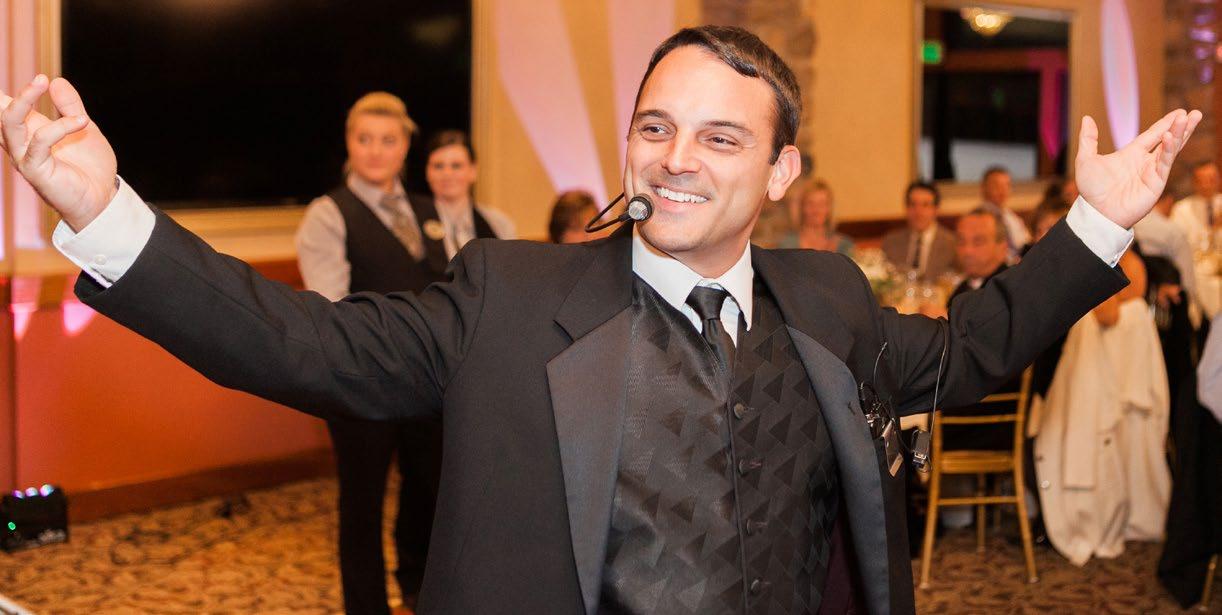
Cosco: Oh, yeah. I think it’s a real problem, too. Years ago, it was phone calls and in-person meetings. They got to see the actual personality of the MC that would be at their event. Now, emails and texts are the predominant communication styles. Zoom is a nice middle ground. I don’t understand how a bride can book the face of their wedding based on only emails and texts.
DJ LIFE: Do you consider yourself primarily an entertainer or a business owner? Why?

Cosco: I enjoy the entertaining, but I am certainly more of a business operator. Ironically, I can’t stand the office portion. Put me on a “stage,”
my headset is a Crown CM311 — now it’s AKG. I have a Rane mixer, Cortex MP3 backup, a BBE Sonic Maximizer – all in a combo case. I use two Ultimate Support stands, and my trusty JBL EON15 G2 powered loudspeakers from the ’90s. I own eight of them, and I will never replace them, as long as they work. I have had to repair them a couple of times, but newer speakers just don’t compare in durability. I am old-school that way. Lastly, I use a drum case to hold all my wires, and supplies. It’s perfect for circular wire bundles.
DJ LIFE: What advice would you give to a young DJ?
Cosco: Be a client-service fiend and a chameleon. The toys – the controllers, the lighting, the PAs, etc. – are great, but that won’t make you money. Those are just tools of the trade. Think about those as a hammer and screwdriver to a carpenter – essential, but not exciting. Focus on returning emails and calls quickly. Also, personal finance is so important. Try not to buy items with a credit card that you can’t pay off in full. Invest, save, and invest in yourself with education. That will last a lot longer than any mic, speaker, or computer.


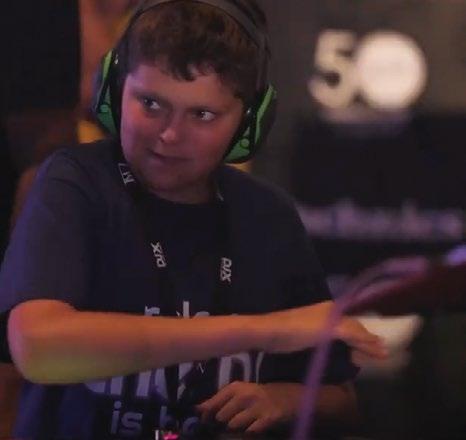





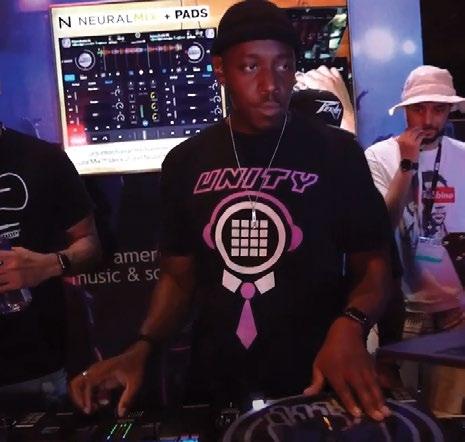
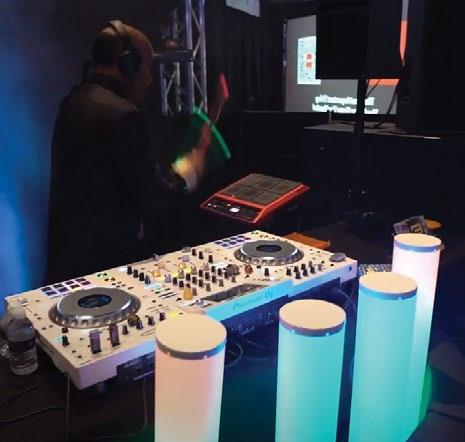





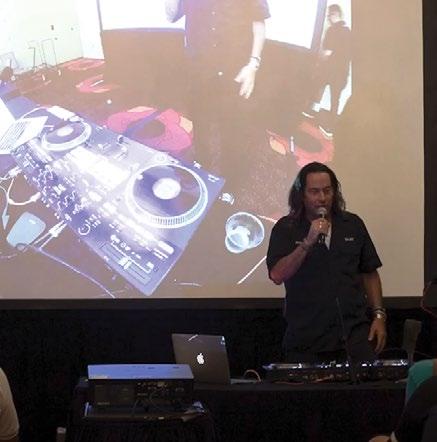



In the mobile-DJ world, there are a lot of different reasons why a client decides to book one DJ over another when pricing or costs are not the deciding factor.
Many times, it comes down to how a DJ provides exceptional customer service. The way a DJ exceeds customers’ needs outperforms any email newsletter, website, social media channel, or landing page.

Customer-experience marketing is the strategic shift that DJs and popular brands will be taking more serious in 2023. It will be an important marketing tactic that drives usage and adoption of your services to fulfill your customer needs. It involves exceeding customer expectations throughout the entire customer journey from first inquiry to after their event.
Customer experience, to be more specific, is the perception your customer has of you as a DJ or your company before, during, and after the booking. Every interaction you have with your client will contribute to their customer experience, whether it’s positive or negative.
In 2023, we will see a massive shift in beliefs about what marketing actually is. It’s no longer about trying to convince clients to book you or work with your company. Instead, the priority has moved towards providing fantastic customer experiences that will create continuous amounts of bookings and gigs. When you focus on building a positive business culture and providing great services that other DJs do not provide, other parts of your marketing almost takes care of itself.
Your clients will expect a seamless experience from the first spark of interest to the customer service after the booking… from personalized messaging that helps them solve problems to even helping them with things they never thought about for their events. If a DJ provides a great experience that delivers quality across all channels, it’s more likely to earn a client’s business. In addition to personalized marketing messages, find ways to listen and
respond to your client’s questions or inquiries in an amazing way as efficiently and quickly as time allows.
The growth of online content has really given consumers more power. They are no longer a passive party when it comes to learning about other DJs and their services. They’re not waiting for you to get back to them or for you to tell them how great your services are. Instead, they’re going out and doing their own research.
So, you have to offer them something more than just information on your website or social channels. In a recent survey, 73-percent of people say that customer experience is an important factor in their buying decisions, but currently only 49-percent of U.S. consumers say that today’s companies provide a good experience. This tells you that companies are not giving what their customers or clients want.

Efficiency, convenience, knowledgeable and friendly service, and easy payment options are what people value most in their customer experience. But traditional marketing is cited, too. Up-to-date technology, personalization, an easy mobile experience, brand image, and design all add up to the overall customer experience.
Can you imagine how your revenue would soar if you went the extra mile to deliver the kinds of experiences that build not only loyalty to you as a DJ, but qualified referrals as well?
When you coordinate your digital-marketing strategy to deliver those kinds of experiences, you’ll grow your bottom line well beyond even your highest expectations. In other words, you need to consider world-class customer experience in every aspect of your marketing strategy.
A happy client is one who is likely to help you boost revenue. And the best marketing you can have are clients who will promote your business for you — the ones who are loyal to your company, continue to promote your business through word-of-mouth, and advocate for your brand and services.
Joshua Volpe is the owner of Kalifornia Entertainment in Rochester, N.Y.

Stanton, an inMusic brand, has released the STX portable scratch turntable. With its mini Innofader Nano crossfader, two recharge able batteries, built-in speaker, and performance-focused portablism features on board, the STX gives DJs instant access to their full turntablist skillset whenever and wherever they’d like. The batteries can easily be charged by connecting the unit to a computer or wall charger using the USB C input. For extended scratch sessions, the USB C input can also be used with external power banks for even more cutting time. Adding beats and loopers is as simple as con necting a smartphone to the Bluetooth input, and the USB port with one-touch recording makes it easy to record a performance for content creation. To top everything off, the latching lid also functions as a stackable, latching base, bring the STX to standard turntable height.
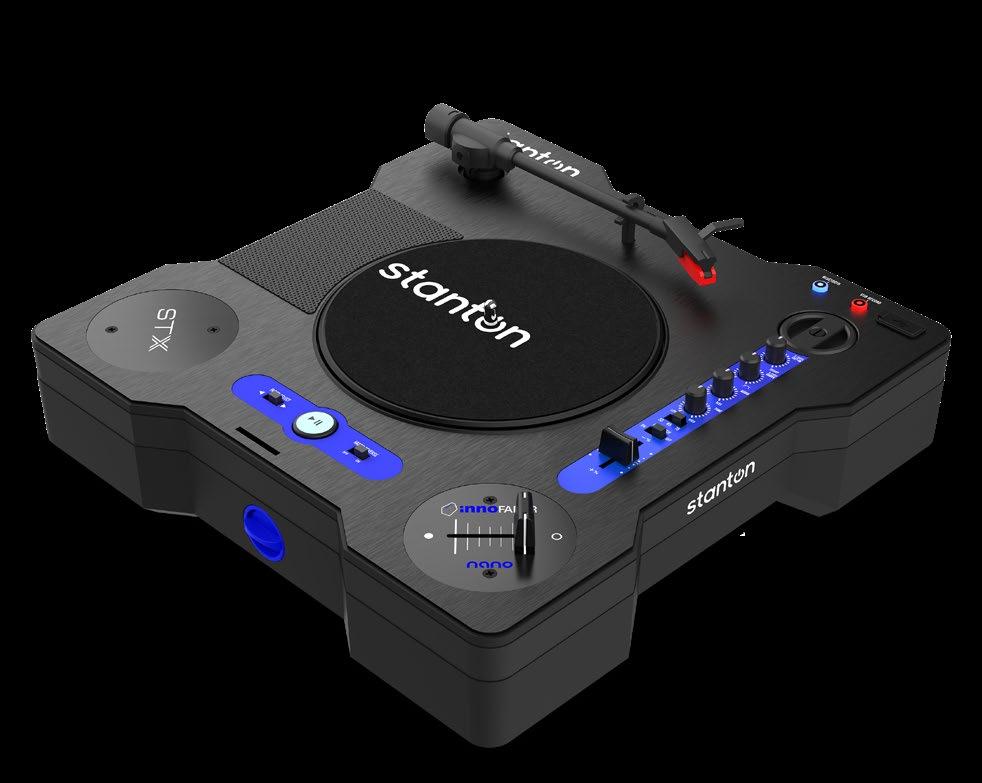
Stanton/inMusic 200 Scenic View Dr. Cumberland, R.I. 02864 (401) 658-3131 www.stantondj.com
Ableton has released Note, a playable iOS app designed specifically for the early stages of the music-making process. Note offers multiple musical starting points with a curated selection of Ableton Live’s drum kits, melodic instruments and synth sounds. Music-makers can also create their own sound palette by recording the world around them into Note’s sampler instruments. Those who want to take their ideas further can use Ableton Cloud to send their Note Sets straight to Live’s browser to pick up where they left off. Note features 56 Drum Sampler kits to use on the 16-pad grid. Loose timing can be fixed by quantizing, or nudging individual notes. Music-makers can choose from 261 synth sounds and 36 Melodic Sampler instruments, which can be played polyphonically using the 25-pad grid or the piano roll. Bespoke drum kits and melodic instruments can be created by recording percussive or tonal sounds into Note’s Drum Sampler and Melodic Sampler. The samples can then be manipulated through cutting, filtering or repitching, and further transformed by adding effects. Ableton Schönhauser Allee 6/7 10119 Berlin Germany (646) 862-7998 www.ableton.com

Germany’s Reloop, distributed Stateside by American Music and Sound, has released the RMX-95 Digital Club Mixer with 24-bit Dual Interface. The professional 4+1 channel club mixer blurs the lines between analog workflow and digital technology. The unit includes a redesigned effects section, optional MIDI mapping of all controls, and smooth integration of the djay PRO AI DJ software. The unit’s 3-band EQ can be adjusted to allow maximum sound control for unique results. Echo, Reverb, Flanger, Phaser, Vinyl Brake, Loop Roll, Noise, Pitch Shift, Delay, Ping Pong Delay, Tape Delay, Bit Crusher and Transformer are just some of the many studio-quality effects included in the brand-new Beat FX unit. The dedicated FX frequency control (LPF/HPF) lets you apply the effects to a specific frequency range for a more unique sound. And each channel also features a bipolar filter unit (LPF and HPF) with real-time resonance adjustment. For connectivity, the unit has four CD, two line, and two phono inputs available on the four input channels. The separate microphone channel has two microphone connections.
Reloop/American Music And Sound 310 Newberry Rd. Bloomfield, CT 06002 (800) 431-2609 www.reloop.com

Serato has released Serato Studio 2.0, a fast and intuitive DAW for making beats. The new DAW provides a robust home for Serato Stems technology, a new innovation in the world of sampling and audio manipulation. Powered by Serato’s one-of-a-kind machine-learning algorithm, Stems enables producers to instantaneously isolate and manipulate four different audio stems, while keeping the audio quality. Stems splits audio into distinct tracks for vocals, bass, drums, and melodies, enabling producers to instantly create a cappellas and instrumental tracks and providing easy integration of additional samples or original sounds with the push of a button. Now embedded in Serato Studio’s powerful sampler, Serato Stems delivers infinite possibilities for sampling and unique sound creation. In seconds, users are able to isolate, flip, layer, and chop with finger-snapping ease without sacrificing sound quality, giving them greater

freedom to sample how they’ve always wanted to sample. As platforms like TikTok have made remixes and mash-ups increasingly relevant and lucrative, Serato and Stems can help producers find an audience and more easily express their creativity.
Serato 80 Greys Ave. Auckland, 1010 New Zealand (800) 515-8268 www.serato.com
Pioneer DJ, an AlphaTheta Corporation brand, has released the XPRS2 loudspeaker series, which includes new active full-range loudspeakers and subwoofers for mobile DJs, live sound, rental, and fixed installations. The four new systems include the XPRS102 and XPRS122 full-range speakers and the XPRS1152S and XPRS1182S subwoofers. Features for the full-range speakers include four DSP modes (Live, Music, Speech and Floor Monitor) and 16 customizable user DSP modes. Features for the subwoofers include three different DSP preset modes—Boost, Extended LF, and Normal—to suit different listening environments.

Pioneer DJ Americas 2050 W 190th St #109
Torrance, CA 90504 (424) 488-0480
www.pioneerdj.com
Numark, an inMusic brand, has released the Mixstream Pro +, its latest addition to the company’s Mixstream Pro series of standalone DJ controllers. The Mixstream Pro + includes all the features of the Mixstream Pro, but also brings access to Amazon Music Unlimited and Serato DJ software compatibility to the party. The unit features built-in speaker monitors with a dedicated volume control. The Mixstream Pro + connects wirelessly to Phillips Hue and Nanoleaf smart home lighting, making it easy to create an exciting party vibe for any occasion. For professional DJs, full DMX lighting control and automation is available by utilizing SoundSwitch desktop software and a compatible interface or dongle.
Numark/inMusic 200 Scenic View Dr. Cumberland, R.I. 02864 (401) 658-3131 www.numark.com

Mixed In Key has released Pilot Plugins, a new generation of artificial intelligence that creates a back-and-forth experience of working between the music producer and the AI to generate melodies, basslines and arpeggios. With this technology, users can create MIDI and audio files that respond to their feedback. Whether on Mac or Windows, Pilot Plugins will speed up the creative process and help users write great music. Pilot Plugins contains three plugins: Pilot Melody, Pilot Bass and Pilot Arpeggio. After selecting a style, users can experiment with the various control knobs to customize the style further. These knobs allow users to adjust parameters such as Rhythm, Density, Shape and other parameters that give precise control over the generation of the MIDI and Audio Files. When users twist a knob, they’ll see new MIDI notes generated in the center preview section.

Mixed In Key 5660 Strand Court #A29
Naples, FL 34110 www.mixedinkey.com
Four years in development, Orbit.6 has been unveiled by renowned mixer designer, Andy Rigby-Jones, and his new venture, Union Audio. The 6-channel rackmounted analog rotary mixer has been engineered to meet the aspirations of audiophile DJ and vinyl lovers. Orbit.6 features a per-channel valve stage, and a fully discrete internal signal path from channel input to mixout. Equipped with four RIAA and eight line inputs, each channel also incorporates an aux send, high-pass filter and a heavily damped rotary fader, using Union Audio’s bespoke “dampR” system. The Master section features an EQ/isolator and custom VU meters. Designed for the home studios of DJs and vinyl enthusiasts, as well as resident mixer in the booths of clubs and entertainment venues, Orbit.6 presents a unique and distinctive listening experience.
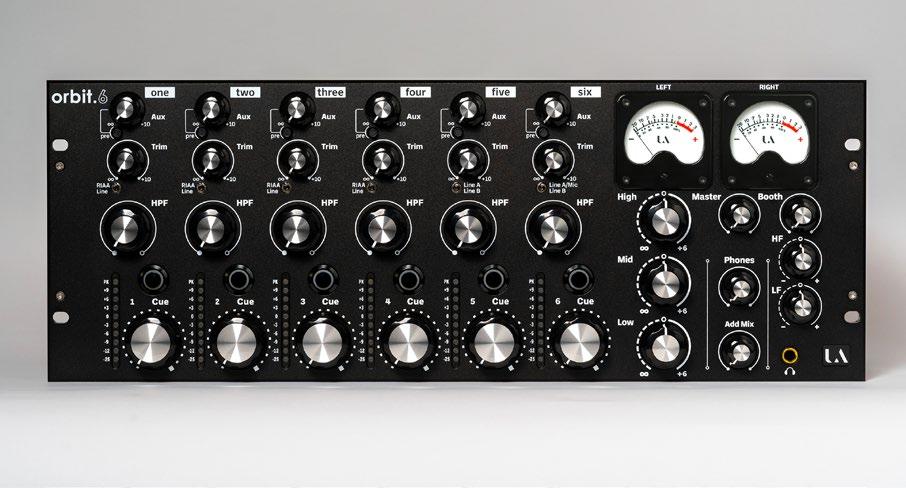
Union Audio Unit 10 Barncoose Ind Est. Redruth TR15 3XX UK www.unionaudio.co.uk
ADJ has added the XLPRO Series of touring-grade audio cables to its Accu-Cable range of high-quality audio XLR cables. Available in sizes ranging from 1 to 100 feet, these professional-grade cords offer excellent audio clarity and exceptional build quality backed by a lifetime warranty. Each cable features one male and one female XLR connection with goldplated contacts. These are linked by heavy-duty cable with an 8mm jacket, low loss 20g copper conductors and a fully braided shield to deliver audio signal transmission with very low noise. The cable is also very flexible and easy to coil. Each cord is supplied with a reusable tie wrap and a color-coded ring on each XLR connection which identifies its length. All XLPRO Series cables are extremely rugged and designed for professional-event production and touring applications, backed by a Limited Lifetime Warranty. This covers the cable and component parts for the lifetime of the original owner’s use of the product.
ADJ Products 6122 S. Eastern Ave. Los Angeles, CA 90040 (323) 582-2650 www.adj.com

Audio-Technica has expanded its offerings for content creation with the AT8700 Adjustable Microphone Boom Arm. Although engineered generally for Audio-Technica’s 20 Series microphones and their use in podcasting, streaming, and other modes of content creation, the AT8700 is just as useful for all other microphones and applications requiring a boom arm. This table-mount boom arm securely attaches to the edge of a desk and features 5/8”-27 thread and heavy-duty suspension allowing full 360-degree rotation, while providing users the ability to place the microphone in the exact position they need when recording, podcasting, streaming, etc. Users can attach their favorite microphone to this professional-quality boom arm to add versatility to their recording or streaming set-up and free up space. The unit comes standard with six USB cable clips, six XLR cable clips, and a table clamp. Additionally, the AT8700 folds for easy transportation.

Audio-Technica 1221 Commerce Dr. Stow, Ohio 44224 (330) 686-2600 www.audio-technica.com
Avante Audio has released the Imperio Pro IMP205. Building on the success of its original Imperio Pro “mini” line array system, the new and improved Imperio Pro Series offers increased output, enhanced audio quality, and new features from the same versatile and compact cabinet design. Intended for easy transportation and very fast setup, the Imperio Pro IMP205 is a lightweight, high-output active line array element that can be utilized in a variety of different configurations – both ground-stacked and flown – to cover a wide range of applications and audience sizes. Combining high quality neodymium components with Class-D digital amplifier modules and advanced internal signal processing, the Imperio Pro IMP205 delivers audio fidelity and deployment flexibility for a speaker of its size. Each Imperio Pro IMP205 array element measures just 12.8- x 7.3- x 8.8-inch (324mm x 184.8mm x 224mm) – the same as the original Imperio – but packs in a pair of 5-inch neodymium low-mid transducers alongside six 1.75-inch IDVAT (Inverted Dome Vertical Array Technology) highfrequency drivers. This configuration allows the unit to deliver a broad frequency response of 100Hz – 20KHz with a wide horizontal dispersion angle of 100-degrees.

Avante Audio 6122 S. Eastern Ave. Los Angeles, CA 90040 (323) 316-9722 www.avanteaudio.com
iZotope, leaders in intelligent audio technology, has released Audiolens, a new desktop app that makes track referencing and comparison simple by collecting and analyzing reference track data directly from any streaming platform or audio source without the need for downloading media files or setting up tedious audio routing setups. Reference tracks offer a representation of the desired end result of a track and are a crucial part of achieving the perfect mix or master. Audiolens aims to streamline the referencing process, assisting engineers that are looking to find balance on a final master for a client and producers that want to make sure their song will stack up on a playlist. The new innovative app gathers information on key sonic characteristics such as tone, dynamics, and width, and saves the analysis as a reference track to help users quickly visualize and compare how their own mixes and masters stack up their chosen references. Audiolens can then integrate seamlessly with the AI-powered Assistants of iZotope plug-ins Ozone 10 and Neutron 4, automatically populating saved referenced targets to the Target Libraries where characteristics can be matched.

iZotope 700 Technology Sq., Ste 400
Cambridge, MA 02139 (617) 234-1200 www.izotope.com
Boss has released the FS-1-WL Wireless Footswitch, a versatile multi-function foot controller for a wide range of applications. Users can control digital music score apps, YouTube videos, DAWs, and supported BOSS and Roland gear wirelessly over Bluetooth. It’s also possible to connect a MIDI cable to operate multi-effect processors, pedals, and other MIDI hardware. And with the dedicated editor/librarian app, the FS-1-WL can be customized to control nearly any software application or MIDI device. Compact and durable, the FS-1-WL is an essential wireless partner for all types of creative situations. It can send keyboard commands over Bluetooth to smartphones, tablets, and computers and comes with three pre-loaded setups for popular apps. With the FS-1-WL editor/librarian app on a Mac/Windows computer or iOS/Android mobile device, users can assign custom keyboard commands to the footswitches, either single keystrokes or combinations with modifier keys like shift and control. And in MIDI mode, custom PC and CC messages can be assigned. The app software also provides the ability to save and organize configurations for different needs.

Boss/Roland 5100 S. Eastern Ave. Los Angeles, CA 90040 (323) 890-3700 www.bossus.com
FabFilter has released FabFilter Twin 3, the latest version of its award-winning virtual analog synthesizer. Almost two decades after FabFilter’s plug-in debut with the FabFilter One synthesizer, Twin 3 expands and improves on its predecessor in every area, including a complete redesign of the GUI and workflow, more and better oscillators and filters, a radically powered-up modulation system, an all-new FX section, and much more. Sonically versatile, supremely intuitive, and spectacularly “analog,” Twin 3 is a dream instrument for creating synth sounds of all kinds, from basses, leads, and pads to plucks, drums, effects, and beyond. Beautiful new interface and improved workflow FabFilter has completely redesigned Twin 3’s interface and workflow, making it more immediately accessible, visually informative, and speedy to navigate than ever, and adding new scaling options and a luxurious Full Screen mode for taking its synth programming environment to the spatial extreme. Individual oscillators and filters can now be added and removed as required, every aspect of the filters is accessed and manipulated within an interactive EQ-style display, and the darker color scheme is less tiring on the eyes over long sessions.

Keizersgracht 467 1017 DK Amsterdam The Netherlands www.fabfilter.com
G-Sonique has released Resonant Techno Reverb RRTX24, a VST plug-in intended primarily for the production of techno music (deep techno, dark Berlin/Detroit techno, minimal techno, hardcore techno, percussive techno etc.), but it can be used in a wide range of genres such as Neurofunk, Dark Ambient, EBM, Experimental, Psytrance, Hitech, Darkpsy, Techtrance, House, Psybient and many others with virtually no genre restrictions. The plug-in produces various types of artificial, as well as realistic spaces, from almost endless celestial halls to paranormalsounding metallic UFO objects to medium-length deep mysterious monasteries. In addition, it creates a large range of resonances – thanks to the nine high/sharp resonant analog filters, a DSP filter inspired by DSP hardware chip devices, as well as a series of two special resonance circuits –Resonator 1 and Resonator 2, which give this reverb a new unique dimension and a previously unknown sound. Reverb’s filter can be additionally modulated by LFO including analog white noise to create brand new hissy analog atmosphere.
G-Sonique Digital Instruments Holubyho Street 921 01 Piestany Slovakia www.g-sonique.com
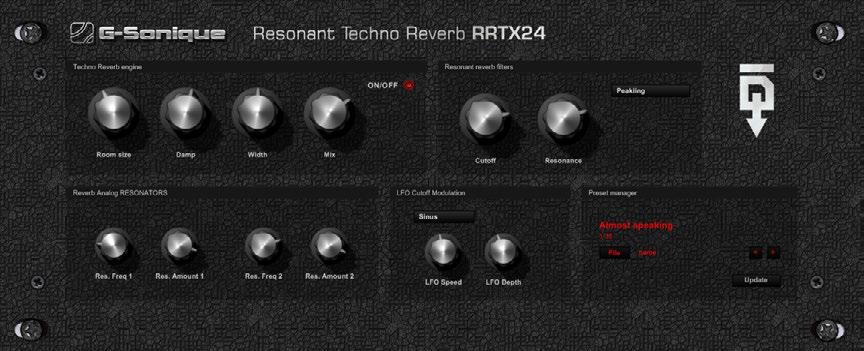
YOUTH MUSIC PRODUCTION AND DJ PROGRAM ON A NEW TRACK REENTRY MENTORING PROGRAM PRISON ELECTRONIC MUSIC PROGRAM
giveabeat.org
giveabeat
igiveabeat
F giveabeat
Give a Beat’s mission is to use the power of music as a pathway to healing and opportunity for those impacted by the criminal justice system.
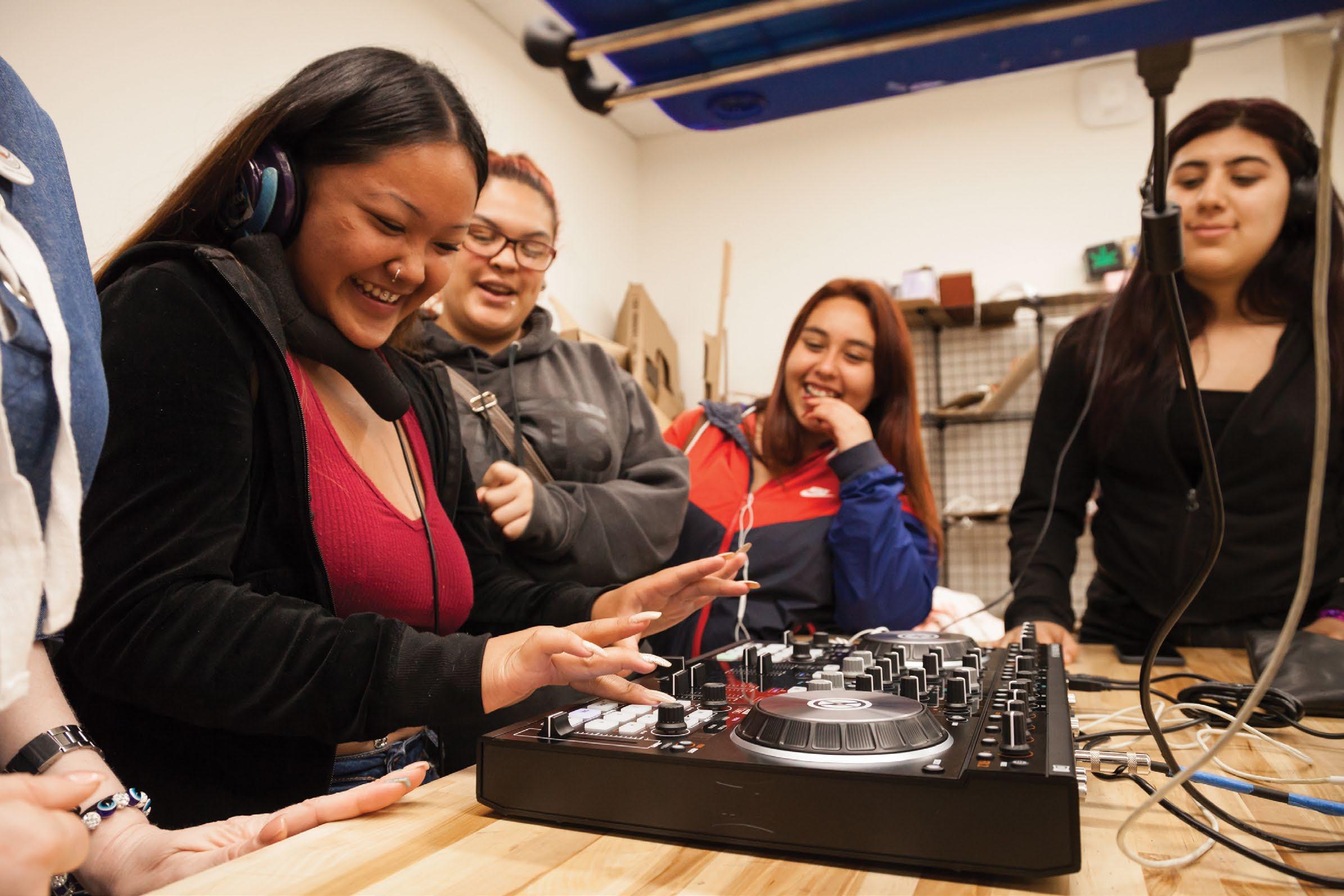
Be a champion for the transformative power of music while promoting social justicebecome a Give a Beat member today!
The I Give a Beat Patreon Membership offers an opportunity to support our mission to use the power of music as a pathway to healing and opportunity for those impacted by the criminal justice system while also receiving valuable perks.
Benefits include discounts and subscriptions to Ableton, Beatport LINK, IO Music Academy, OM Records, ROSTR, great swag and more!
giveabeat.org/PATREON
Dombresky
Sink Or Swim
Loaded with soulful vocals and filtered effects, this disco-tinged slammer pumps with a solid house rhythm and an ultra-catchy hook. A real earworm.
– Jim Tremayne“Hold Me”
Sam Monie feat. Daniela Rhodes
Superfreq
Manic acid lines snake thru a clapping rhythm and a yearning female voice, resulting in a more-than-trippy tech-house journey. On Mr. C’s slightly more pulsing, but no less bewildering remix, the track’s burbling bassline lets loose like jackrabbit. The B-side “Bing Bong” packs a bigger 4/4 wallop and increases the tension as the track skids along. Looking for a brain massage to go with some whopping grooves? Look no further.
 – Jim Tremayne
– Jim Tremayne
The Blessed Madonna & Jamie Principle
Warner Records
Tweaky and relentless, this stripped-down paean to the classic days of Chicago house music hits all the right marks – from the grooves on the dancefloor to the politics outside the club. The Blessed Madonna brings in house legend Principle for an obstinately powerful track that celebrates the past, but stands firmly in the present. Terrific.
 – Jim Tremayne
– Jim Tremayne
“Push to Start”
Noizu & Westend feat. No/Me
Insomniac Records
This frenetic house tracks kicks off with a mad build then gets pumping with a rumbling bottom with some exhilarating synth wooshes on top. After that, the builds and drops get even more manic. This one will rock any club or fest. “Push my button/Push to start it,” indeed.
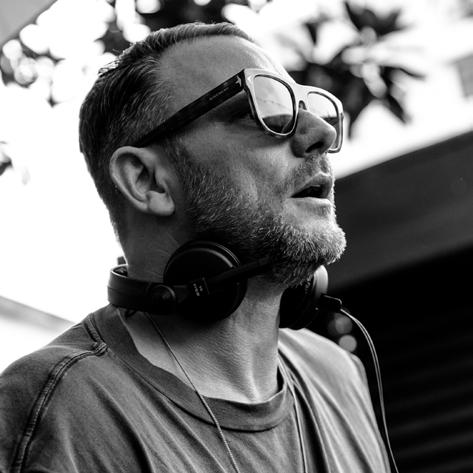 – Jim Tremayne
– Jim Tremayne
Mark Knight, James Hurr & Todd Terry Toolroom
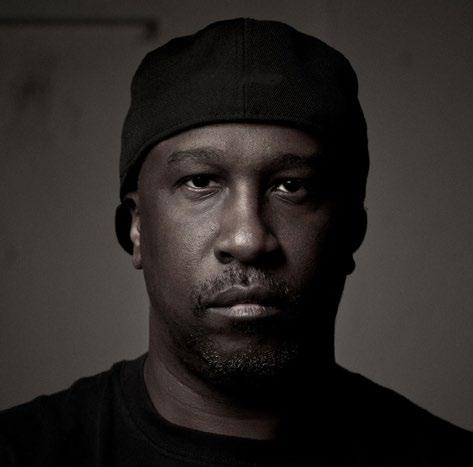
Bouncy and big-room blasting, this feel-good collab delivers synth stabs, hip-shaking rhythms and soulful vocal samples that’ll light up a dancefloor. A hands-in-the-air, peak-hour track for house-music lovers.
 – Jim Tremayne
– Jim Tremayne
“Grumble Bumble”
Steve Bug
Rejected
Moody and dark, yet oddly melodic before it starts chugging hard, Bug’s latest deep-tech track should work for any late-night gathering. The B-side, “Get Away from Me,” percolates a slightly jazzy vibe and flaunts tasty female vocal stabs before ominous synths kick in. A solid double dose.
“Sugar”
Riton feat. Soaky Siren
Big Beat/Atlantic
By ramping up the beats on 50 Cent’s “Candy Shop,” this bouncy, pop-inflected number pushes plenty of spice onto the dancefloor. Energetic, with a big wind-up/drop combo that’ll satisfy.

“Legend”
Adam Beyer

Drumcode


Ascending and hypnotic, this techno stormer builds to a spacey crescendo and delivers a mighty drop. A real 3 a.m. burner, “Legend” will shake hips and rattle some senses. Tough and groovy.
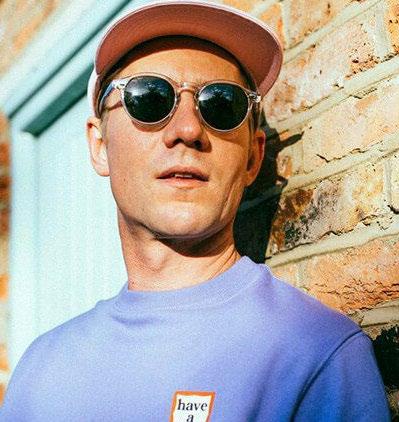
– Jim Tremayne
“The Freaks”
David Guetta x Marten

Hørger
Spinnin
A genuinely stompin’ future-house track that thumps, builds, careens, and wiz-bangs its way into your head. Wildly ravey, “The Freaks” is quite a rollicking rollercoaster ride.
“SOS” (Skylark Remix/Nic Fanciulli Edit)
A’Studio feat. Polina
Defected
Revisiting his remix of this 2006 release, Fanciulli’s new edit shimmers with new energy, as he bumps up the beats with a sizzling bassline and whopping rhythm. Melodic and once again memorable.
 – Jim Tremayne
Riton
– Jim Tremayne
David Guetta
– Jim Tremayne
Riton
– Jim Tremayne
David Guetta
1 Alfredo De La Fe feat Alex Abreu A Otro Con Ese Cuento Altafonte
2 La Fuga Cali Es Un Vacilon (Cubanito Remix) Slammin’
3 Pablo Perez Mi Ritmo Tiene Fuego PPB
4 Karol G x Romeo Santos X Si Volvemos
5 Lefty Perez feat. Gilberto Santa Rosa Ni Para Ti Ni Para Mi LOMG
6 Enrique Feliz x Rafa Rosario Las Mujeres Ajenas
7
Most Added Tracks
■ Gary Canavo masspooldjs Saugus,MA
■ DJ Sticky Boots The HyperMiXx Syndicated
■ The Dance Environment What’s In-Store Music Los Angeles, CA
■ Manny Esparza Nexus Radio Chicago,IL

■ Howard HK Kessler In The Mix With HK Syndicated
■ Peter K. Productions Peter K Syndicated
■ Brian Stephens Mixxmasters Lithonia,GA
■ Randy Schlager KNHC 89.5FM Seattle, WA
■ DJ Ilan Fong Multiple Pod Casts Columbus, OH
■ Michael Cerchiai House Of Pride Radio San Francisco, CA
■ DJ Spawn Mix 93 FM Los Angeles, CA
■ Miss Joy TAO Group Las Vegas, NV
■ Chris Egner Victors Milwaukee, WI
■ Alan Chasen OMAP Washington, DC
9
1 Rosalia & Cardi B Despecha Columbia
2 Pitbull x AYYBO x ero808 Right Or Wrong (Hypnosis) Mr 305
3 Edwin “El Calvito” Perez Ahora Me Toca A Mi Con Clase
4 Ray Viera Pachecolandia RV Discos
5 KD One & Lil Jon Vamos A Beber (Sak Noel Remix) Dim Mak

■ Latinos Unidos Record Pool
■ Salsamania Latin Record Pool
■ Lobo/Bass Record Pool
■ North East Record Pool
■ Mixx Hitts Record Pool
■ Ritmo Camacho Record Pool
■
■
■
■
■
■
ATTENTION DJ LIFE READERS: DJ Life is currently looking for DJs that are interested in reporting to the DJ National Dance/Crossover chart and the DJ Times National Urban Dance chart. Reporterships are open to Record Pools and individual DJs. For more information contact: Dan Miller, dmiller@hazanmediagroup.com
